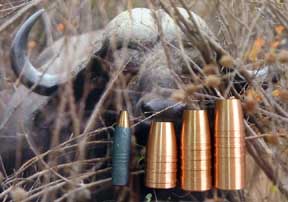

 The Accurate Reloading Forums
The Accurate Reloading Forums  THE ACCURATE RELOADING.COM FORUMS
THE ACCURATE RELOADING.COM FORUMS  Rifles
Rifles  Big Bores
Big Bores  .375/404 Jeffery Saeed of 2012: Adventures and Misadventures
.375/404 Jeffery Saeed of 2012: Adventures and MisadventuresGo  | New  | Find  | Notify  | Tools  | Reply  |  |
| Moderator |
I just watched Saeed's video from Zim '96 again. Saeed was definitely using the original 375-404 with the muzzle brake. It is also the year Saeed shot the 49" buffalo with it. It is the earliest video I have, so I can't say for sure if it is the first time Saeed took it to Africa, but I get the feeling from some of the banter between Saeed and Roy at the sight-in session and about the performance of the bullets on game that it was. Got a kick out of Walter playing "African Golf" with elephant femurs too. Cheers! Chris | |||
|
| one of us |
Canuck, Thanks. That is probably as authoritative as we are going to get on the date of origin of the ".375/404 Jeffery Saeed of 1996." Saeed and Walter sure don't seem to keep records, other than their videos, and postings to this website. I contacted Dwight Scott, co-designer/gunsmith extraordinaire on the first one. He was no help. No records could be found in his piles of papers. The original reamer maker, Dan Green, is out of business or lost into employment by another firm ... 1996 it is! We are the authorities ... unless Saeed can do better. The barrel for the second ".375/404 Jeffery Saeed of 2012" from Pac-Nor is more than 4 months past ordered, still waiting. 18 years from origin to imitation. We do have another member here saying he is waiting for a barrel from Dan Lilja, same as my first one ... but he is planning on an M70 Winchester. Excellent. I will have a CZ 550 Mag and an FN Mauser 98, 12" twist and 10" twist respectively, for a pair. 26" and 23" barrel lengths respectively. | |||
|
| Moderator |
Updated... In 1996 the 375-404 was Saeed's heavy rifle, and he had a smaller rifle with a Leupy scope sporting a 50mm objective. It was a 270 Ackley with 130gr Aframes at 3200 fps. Saeed was still using the original 375-404 in 1997 as well and still with the muzzle brake uncovered. He was also using a 7mm Lazzeroni. In 1998 Saeed used a 338 Lazzeroni and the original 375-404 with the muzzle brake still uncovered. In 1999 Saeed used the old 375-404 and a 9.53 Lazzeroni. With the 375/404, Saeed used two loads, both with the Barnes X 300gr bullet, but one at 2650fps and another at 2810 fps. | |||
|
| one of us |
After 5 months wait on the Pac-Nor .375-caliber barrel, they told me it did not pass QC, so they are starting over. This gave me a pause to reconsider rifle number 2: I will have it done on a Win-M70, rebarrel the 404 Jeffery African sheep rifle. It will be a switch barrel now. The FN Mauser will become a 500 Mbogo Short, using the Wiebe bottom metal kept at 3.50+" inside box length. The lack of progress with rifle number 1 load development is also due to waiting for proper reloading dies from Hornady for the .375/404 Jeffery Saeed of 2012. Should get done in 2012 ... maybe. | |||
|
| one of us |
Hornady has shipped the reloading dies. Will post "proof of life of dies" photo when they arrive. | |||
|
| one of us |
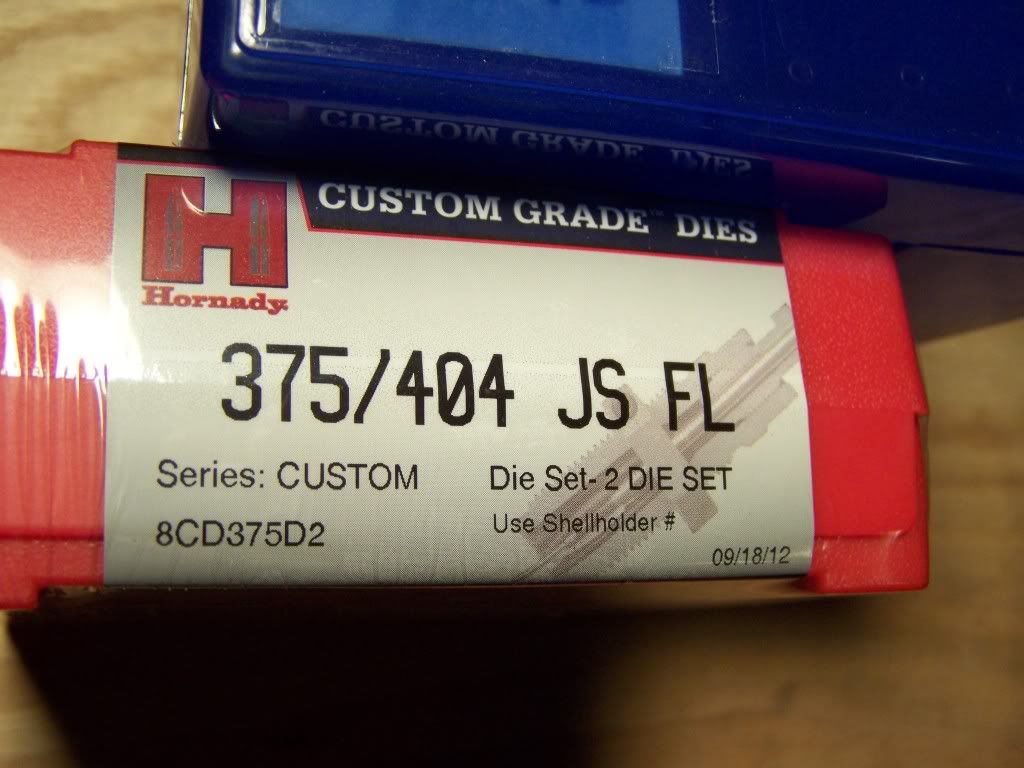 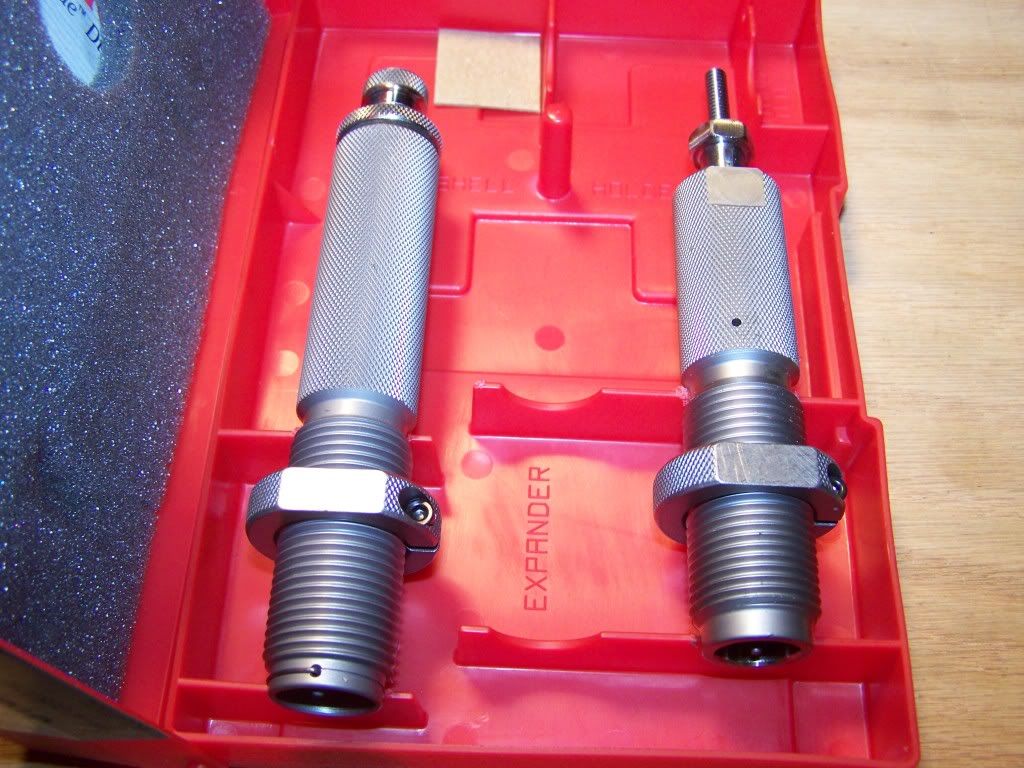 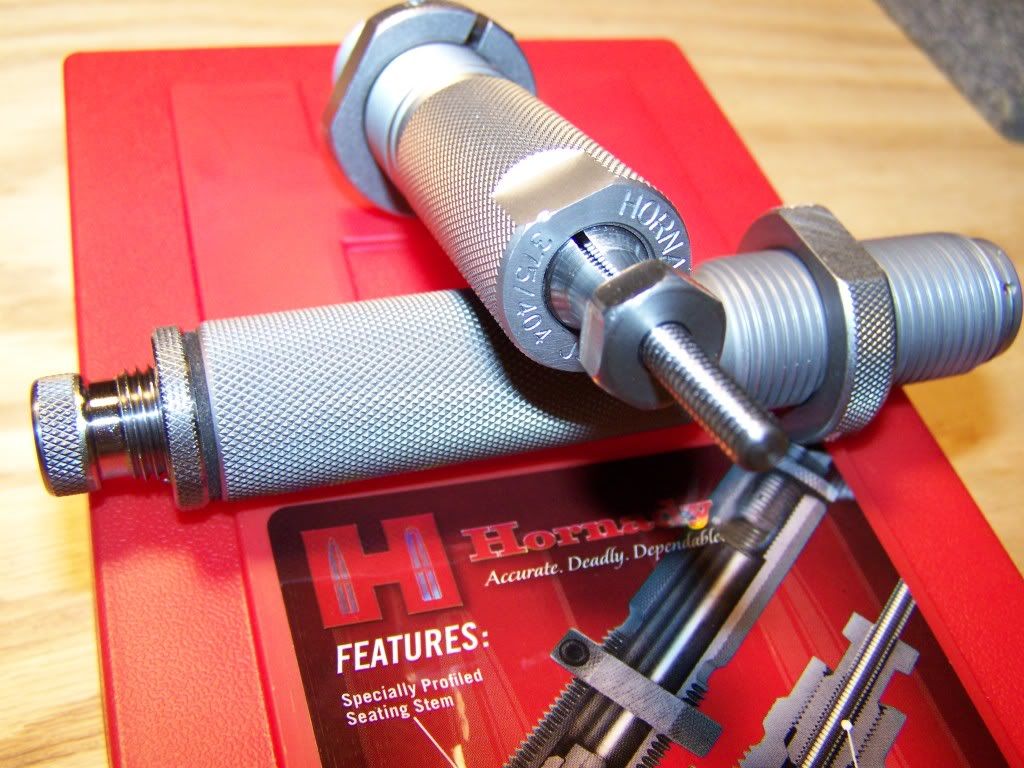 Released to the guntrade. Hornady routinely exports via USPS. | |||
|
| one of us |
First batch of properly sized brass, Hornady dies great so far, ought to start seeng some accuracy from this: 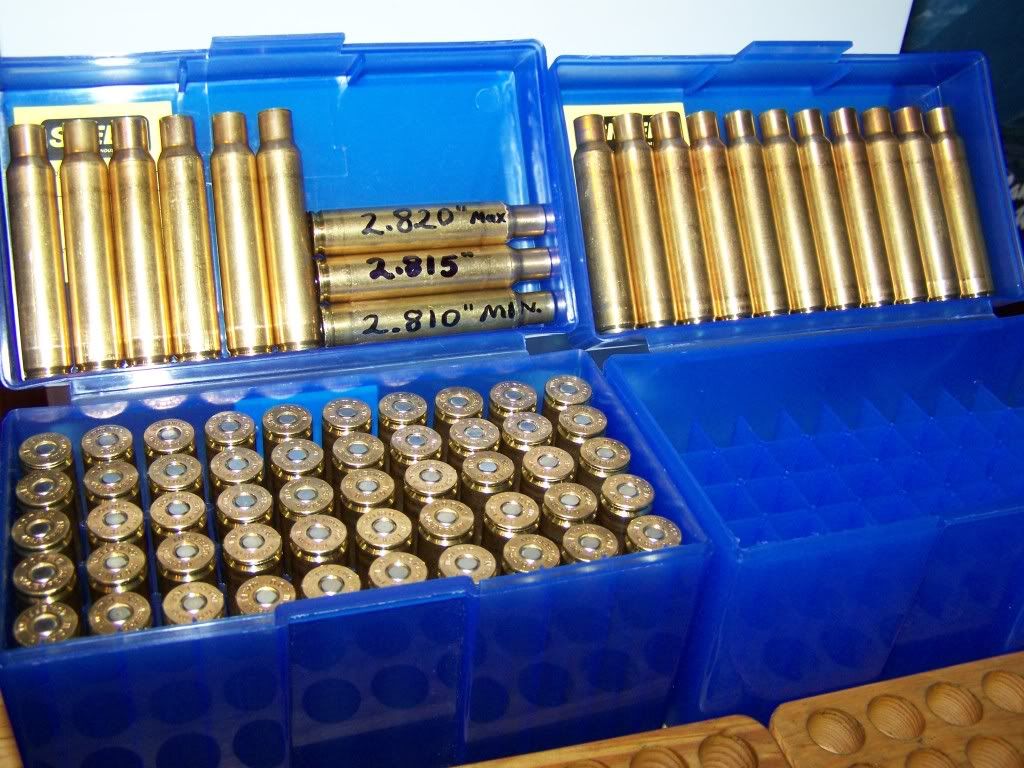 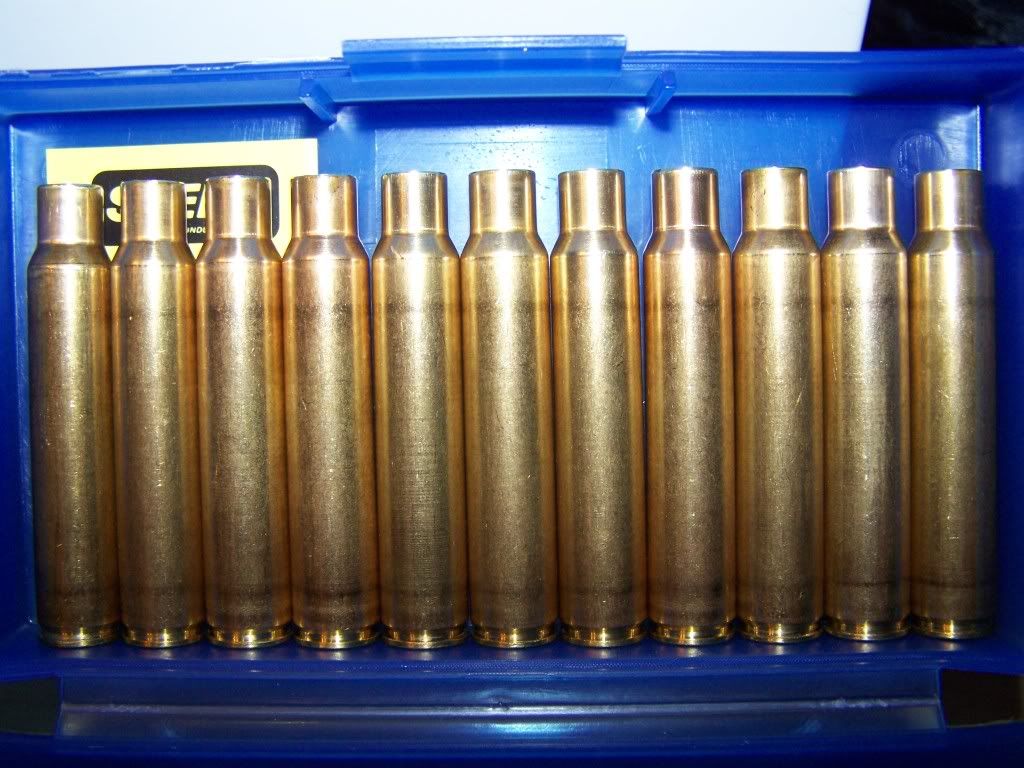 The three "trim gauge" cases are wrapped with clear tape to keep the marker from rubbing off. I have not done any annealing, tumbling, nor external cleaning, except for wiping the soot off the necks. Just raw Norma 404 Jeffery brass that was necked down, trimmed to 2.830", and fire-formed. Then the fireformed brass was lubed, sized, trimmed to 2.810", necks chamfered, primer pockets cleaned and the flash holes uniformed. Maybe I will anneal and shine it up after the first full-steam firing, and eventually do the same to 100 more pieces. Maybe Hornady brass? | |||
|
| one of us |
Easy: 85.0 grains of H4350 Extreme with "any 300-grain bullet you want" will be the starting load. Work up from there. Then maybe a faster powder or more of same for CEB ESP Raptor-Talon-Tipped 230-grain/.375-caliber "hexploding" bullets. Brass hollow point with plastic ballistic tip. Walter might like the "hexploding" part. The ".375/404 Jeffery Saeed of 1996" at work in 2012, ongoing, real-time now: http://forums.accuratereloadin...1411043/m/2341013081 A-Team: 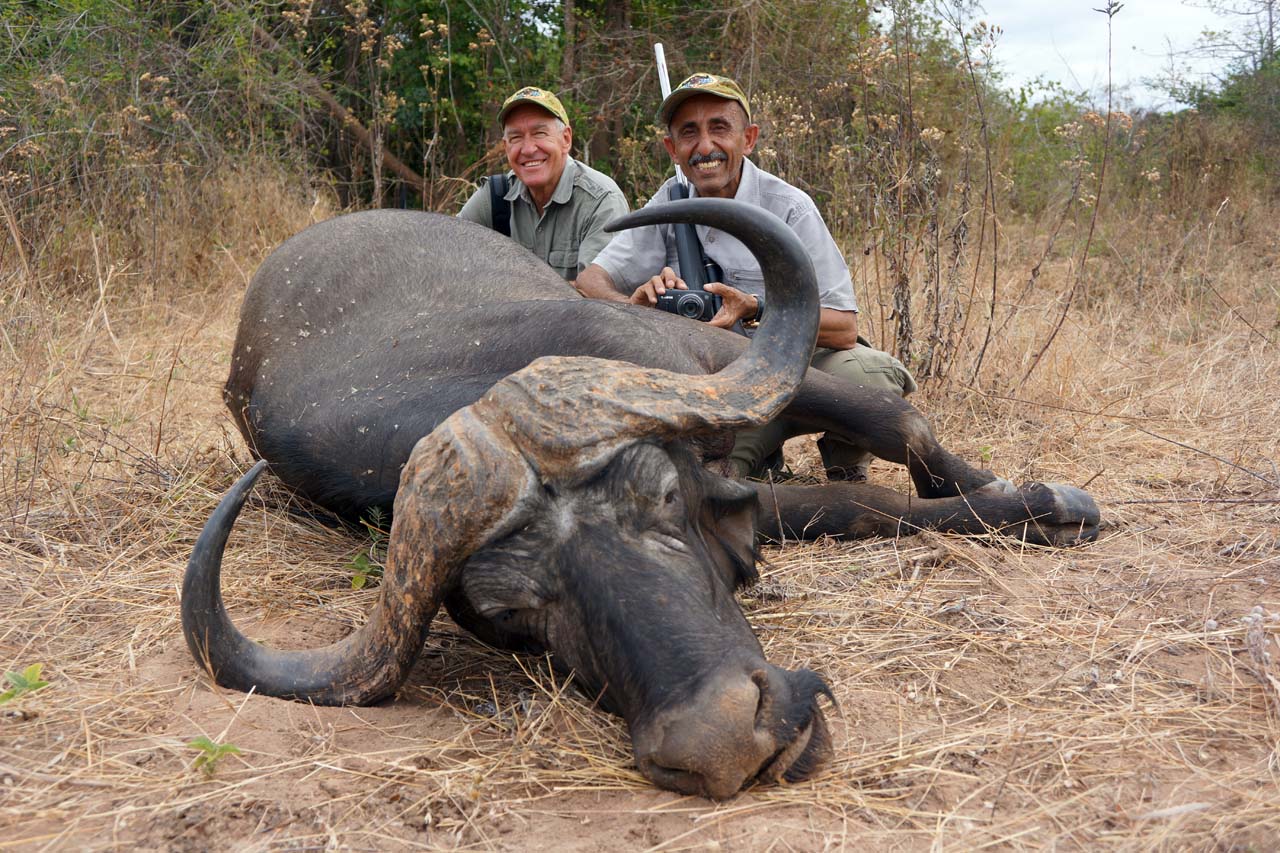 B-Team: 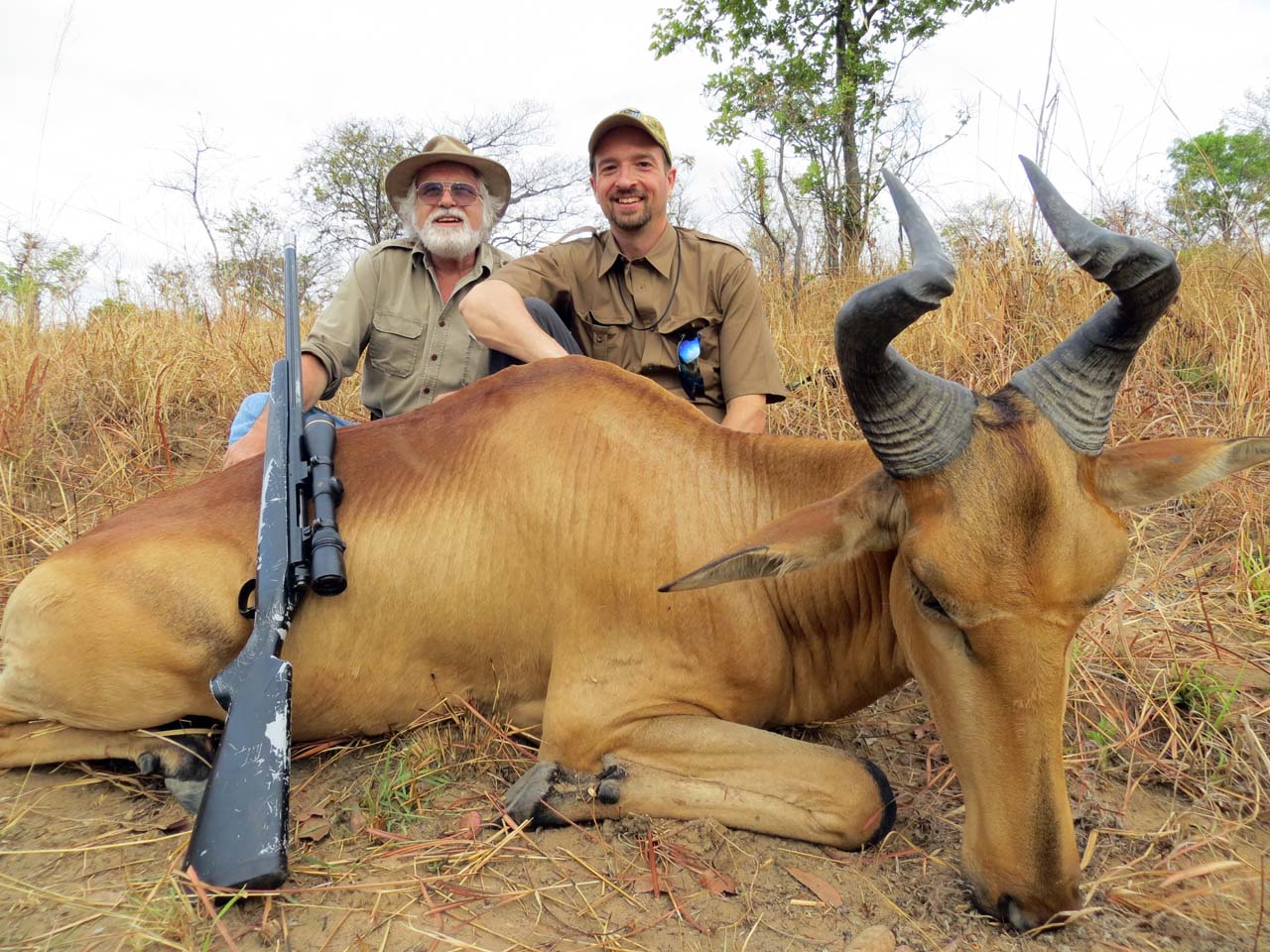 | |||
|
| one of us |
I have one Saeed-made Walterhog bullet sample, and twenty copies made by Bridger Bullets, a sample from some years ago. Single Walterhog (moly-coated) weighs 300.5 grains, is 1.556" long, and major diameter is 0.375". The Bridger-Walterhog and 6 other bullets were weighed and measured in a sample of 5 each for preliminary loads: 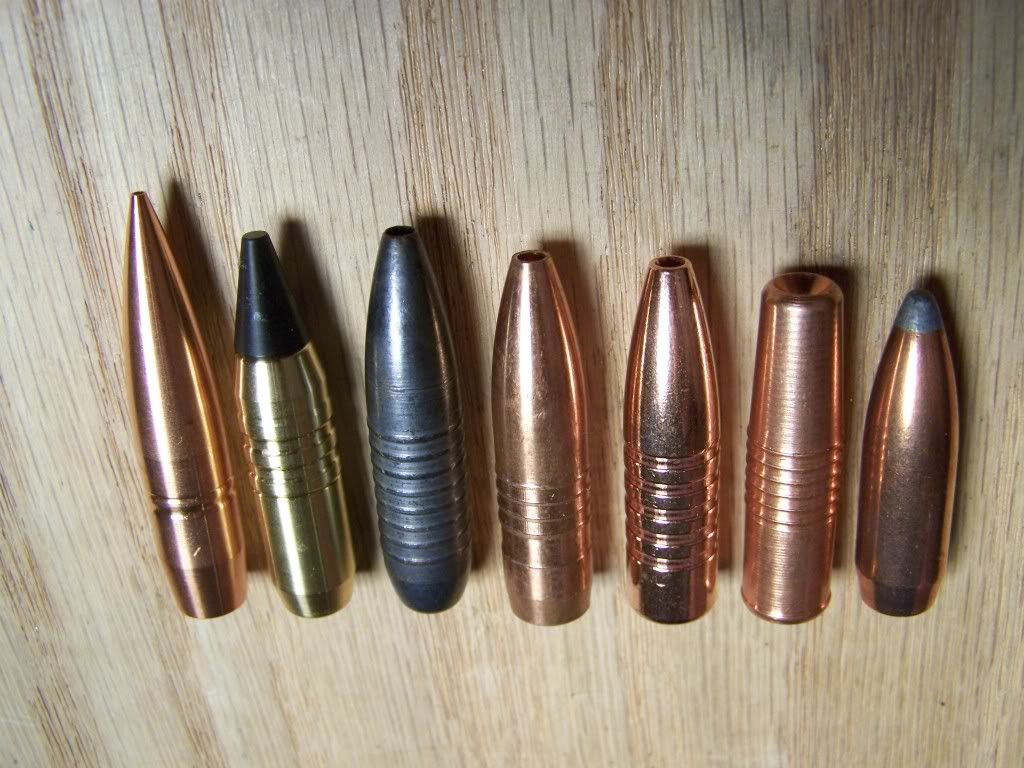 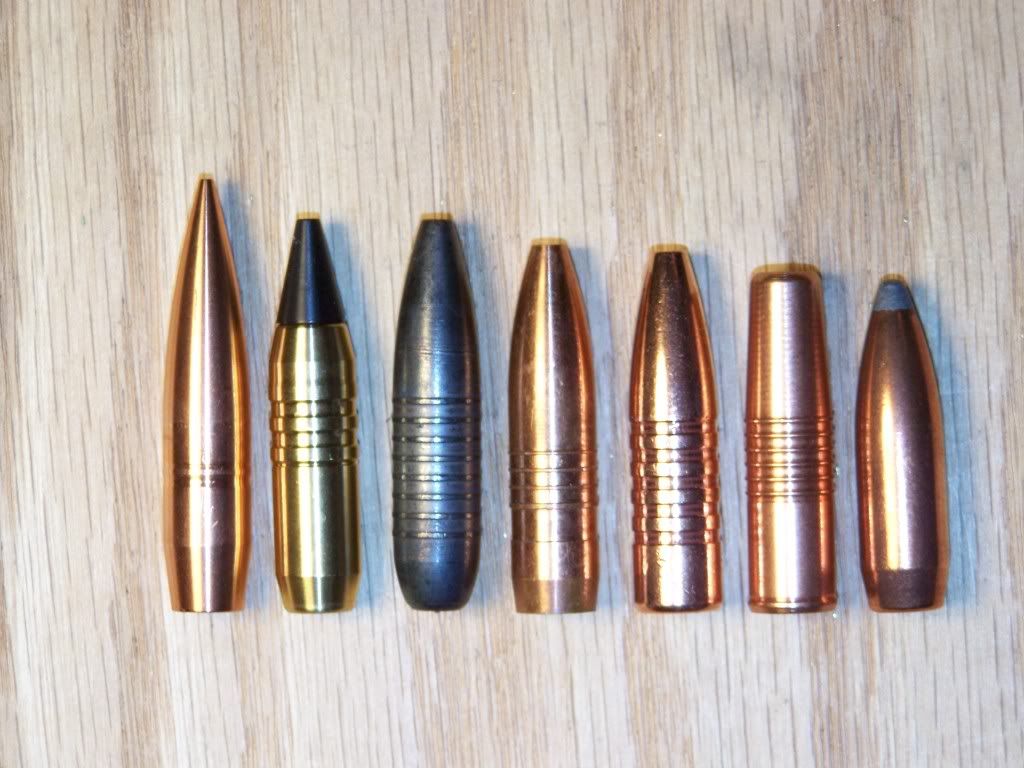 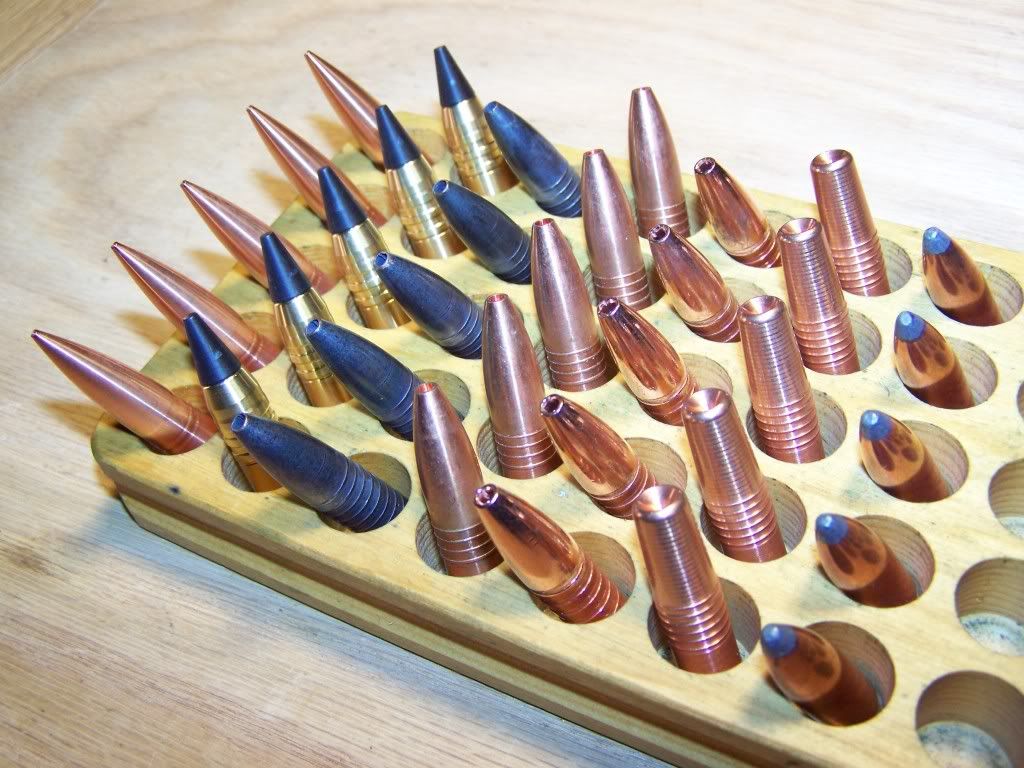 Left to right, 7 bullets and averages for sample of 5 each: *********************************************************** 1. CEB MTH L01 LD HPBT-MAX 320-grain (copper): 320.0 grains, 1.801", Seal-Tite band 0.377", remainder of bearing diameter is 0.375" 2. CEB ESP L230 Raptor (brass plus plastic Talon Tip) "230-grain": 230.1 grains (no tip), 236.9 grains with tip insert, 1.635", 0.375" major diameter of brass bands, 0.366" fore and aft of bands, and 0.357" (between the 3 bands) 3. GSC HV 300-grain (moly-coated copper): 299.9 grains, 1.624", major diameter 0.376" (bands), minor diameter 0.368" (between bands) 4. Bridger-Walterhog 300-grain copper with no moly coat: 300.9 grains, 1.523", major diameter 0.375" (bands), minor diameter 0.365" (between bands) 5. Barnes TSX 300-grain copper: 299.9 grains, 1.493", major diameter 0.375", minor diameter in the 5 cannelures varies from 0.359" to 0.364" 6. North Fork Cup Point "expanding" Solid 300-grain, vintage Mike Brady, copper: 299.8 grains, 1.408", major diameter 0.375" (bands), 0.360" between bands, bore riding base shank is 0.364", and terminal base band is 0.375" 7. Sierra GameKing 300-grain cup&core, gilding metal and lead: 299.8 grains, 1.371", bullet diameter 0.375" ************************************************************************************************************** Thought I might try all 300-grainers with 85 grains of H4350 for starters. Then H4831SC with the 320-grain CEB. And Varget with the CEB 237-grain ESP Raptor with Talon Tip. BTW, GSC recommends a 1:10" twist for the 300-grain GSC HV, though everybody else is good with 1:12" twist, including one make that is both longer and heavier. Gerard might also think the 300-grain HV is best if restricted to use in 378 Weatherby. We'll see how it does in the 375/404 JS. BTBTW, recall that my 375/404 JS of 2012 is throated like this: 0.3700" of PS-free-bore length, 0.3756" PS-free-bore diameter, 1-degree-7-minute leade. With free-bore diameter (0.3756") being smaller than the diameter of GSC driving bands (0.376") seating depth is fixed, "deep." There is a +0.015" chamber length tolerance beyond max brass length then the chamber neck's mouth chamfer, some room to fit that first band of the GSC. Should be interesting, with all these bullets, as none will have much chance to get cock-eyed before entering the rifling. | |||
|
| one of us |
Who says the Three-Seven-Five is inadequate for buffalo? Saeed's .375/404 Jeffery, note Walter's favorite color of fingernail polish ceremonially dabbed in the flutes of the barrel: 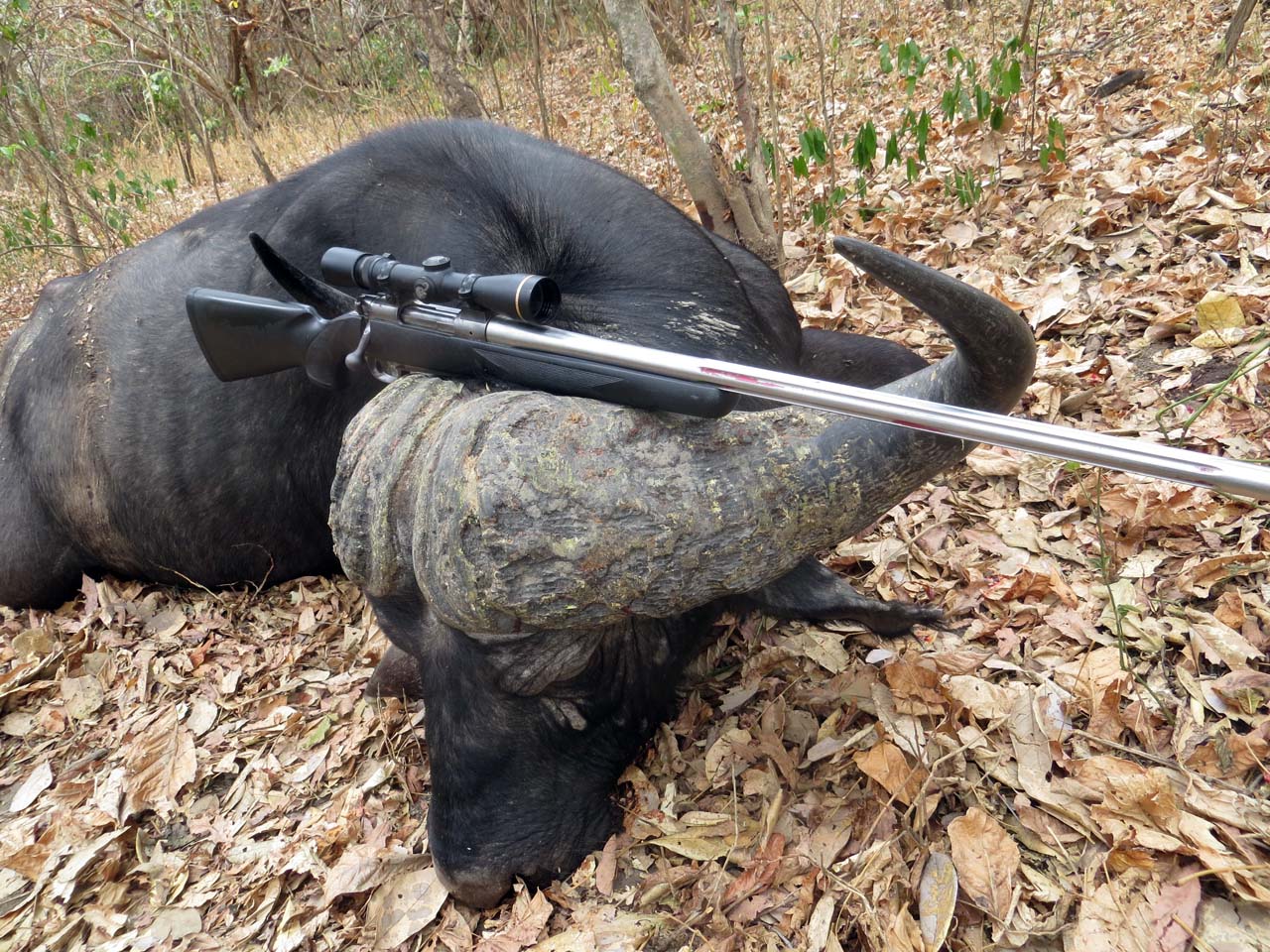 Second buffalo came to bag on day 4 (10-02-2012) of current "Saeed Safari." Technical: Saeed is using only 85 grains of H4350 with his 300-grain Walterhog. QuickLOAD estimation of pressure and velocity coming up ... | |||
|
| one of us |
375/404 JS: H4350-Extreme 85.0 grains (91 % fill) COL = 3.691" 300-grain Walterhog, Moly-coated: MV = 2655 fps, Pressure = 47,386 psi No-moly: MV = 2666 fps, Pressure = 48,440 psi In QuickLOAD, moly reduces the start pressure of a copper bullet by about 33%. So it allows a teeny-tiny gain in velocity for teeny-tiny decrease in pressure, near max pressure, if a few tenths of a grain extra powder is used with the moly-coated bullet. If max pressure is assumed to be 63,817 psi, with same bullet, powder choice, and COL as above, for the .375/404 JS, max powder charges then are about like this: Moly-coated: 92.8 grains (100 % fill) >>> 2884 fps @ 63,693 psi No-moly: 92.4 grains (99.6 % fill) >>> 2880 fps @ 63,815 psi Above for 26" barrel which burns the H4350 to this degree: 85.0 grains gives 99.7 % of propellant burnt. 92.8 grains gives 100 % of propellant burnt. I think it is safe to start at 85.0 grains of H4350 and no moly, even with the 320-grain CEB. | |||
|
| one of us |
10-3-2012 action in Tanzania for the .375/404, latest trophy pics available for these two rifles: 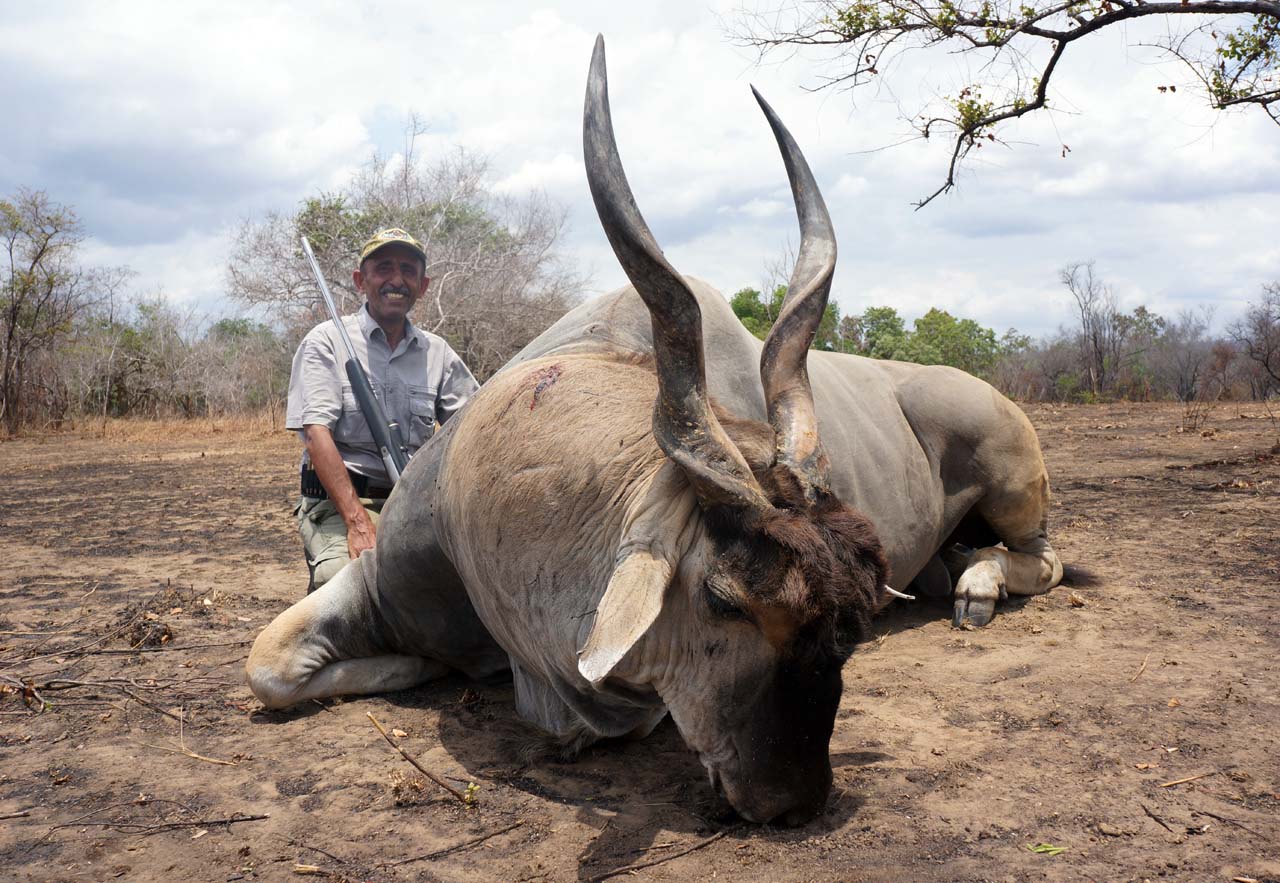 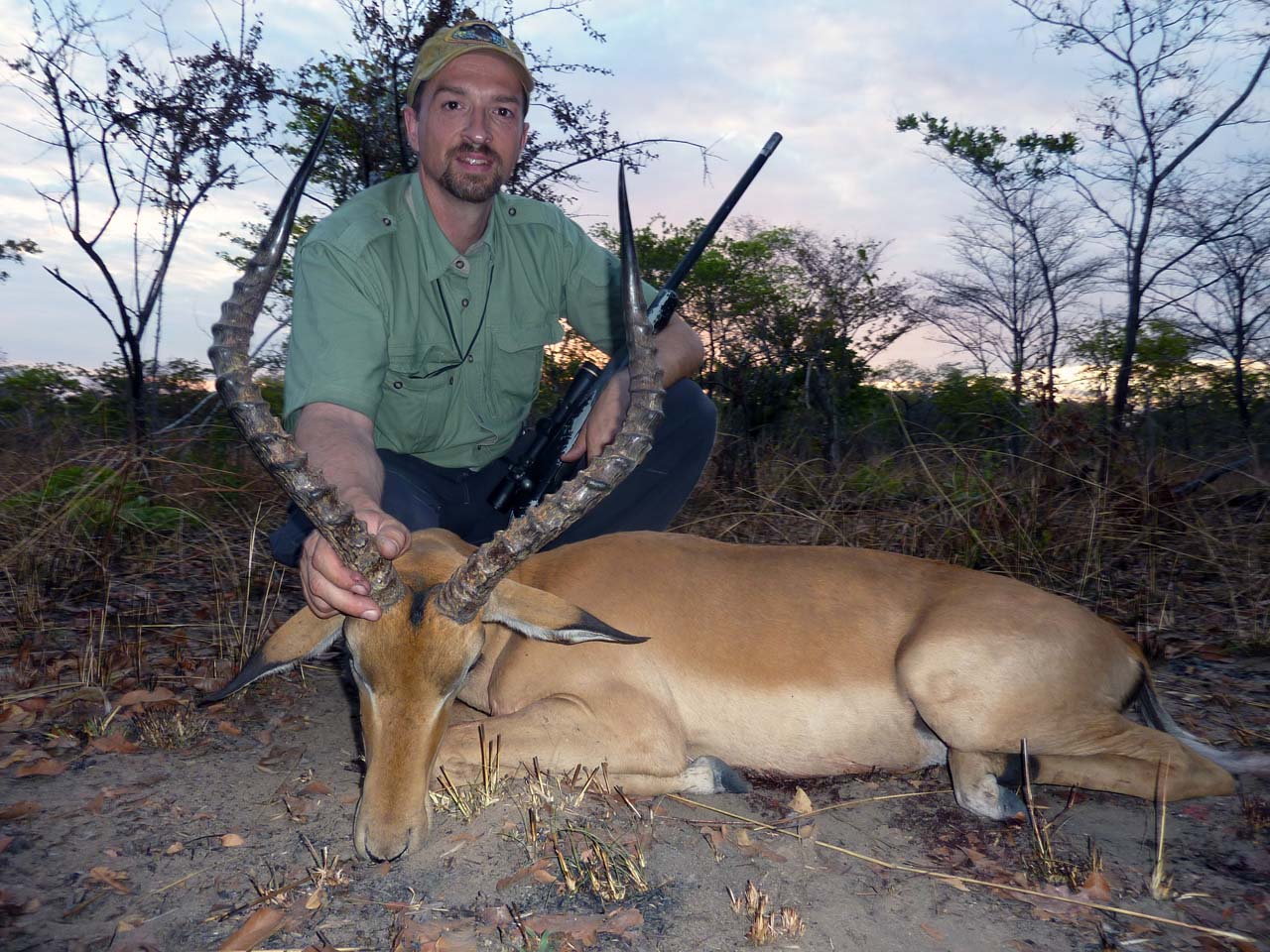 QuickLOAD simulations for other of the above pictured bullets: CEB MTH L01 320-grainer: COL: 4.061" (single-shot loader) H4350 88.0 grains (91 % load) >>> 2719 fps @ 60,861 psi H4831-SC 96.0 grains (98 % load) >>> 2729 fps @ 62,049 psi CEB ESP R-T 236.9-grainer: COL of 3.690" (loaded long) for my CZ 550 Magnum rifle: VARGET 88.0 grains (100 % full load) >>> 3102 fps @ 62,663 psi H4350 94.0 grains (104 % compressed load) >>> 3104 fps @ 55,833 psi ... And same bullet now loaded "short" to COL of 3.565" for a Winchester M70 box: VARGET 86.0 grains (101 % compressed load) >>> 3090 fps @ 63,008 psi H4350 92.0 grains (105 % compressed load) >>> 3095 fps @ 56,377 psi But the Winchester might have a 23" 1:10" twist barrel instead of the 26" 1:12" twist barrel of the CZ ... | |||
|
| one of us |
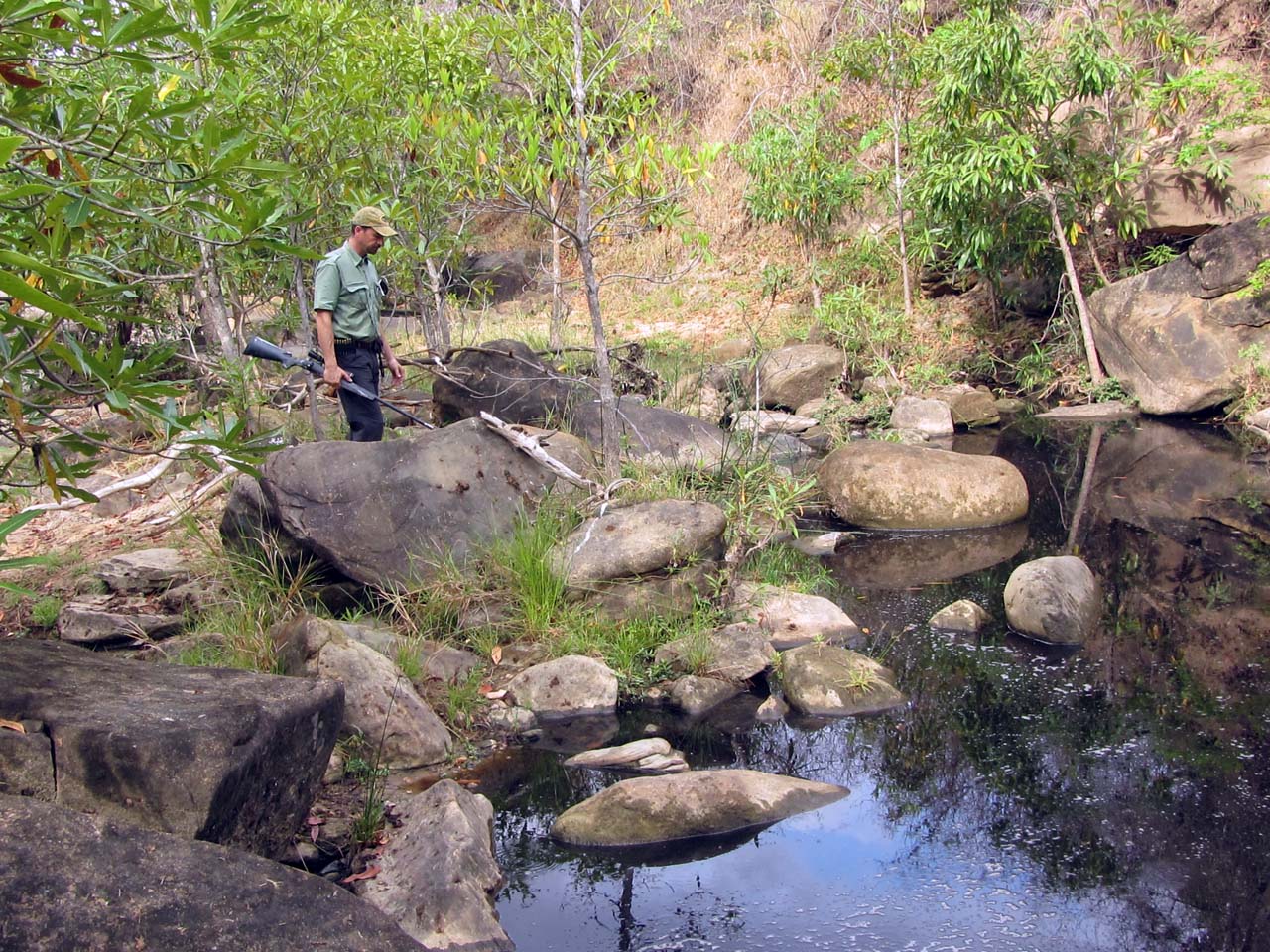 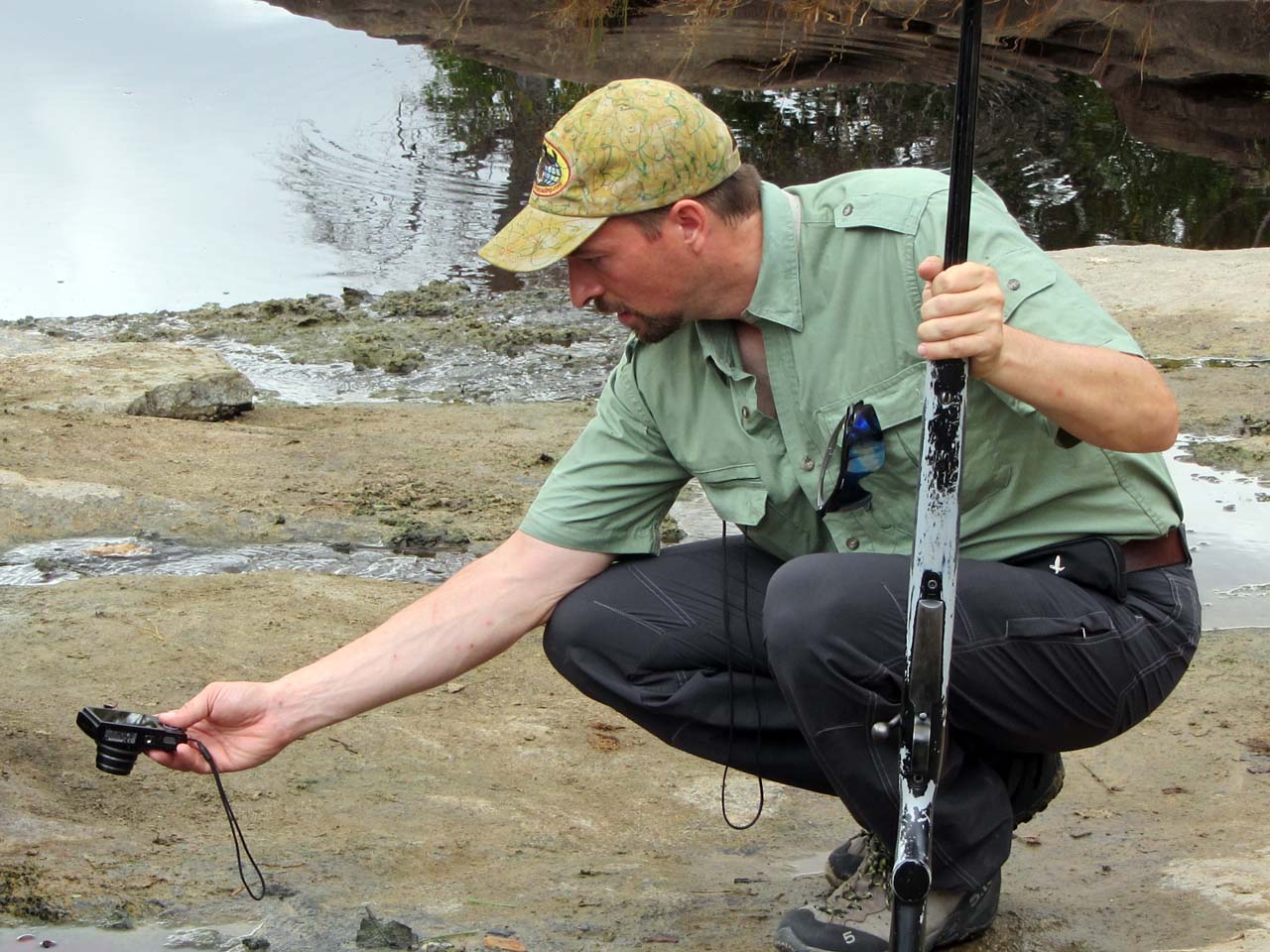 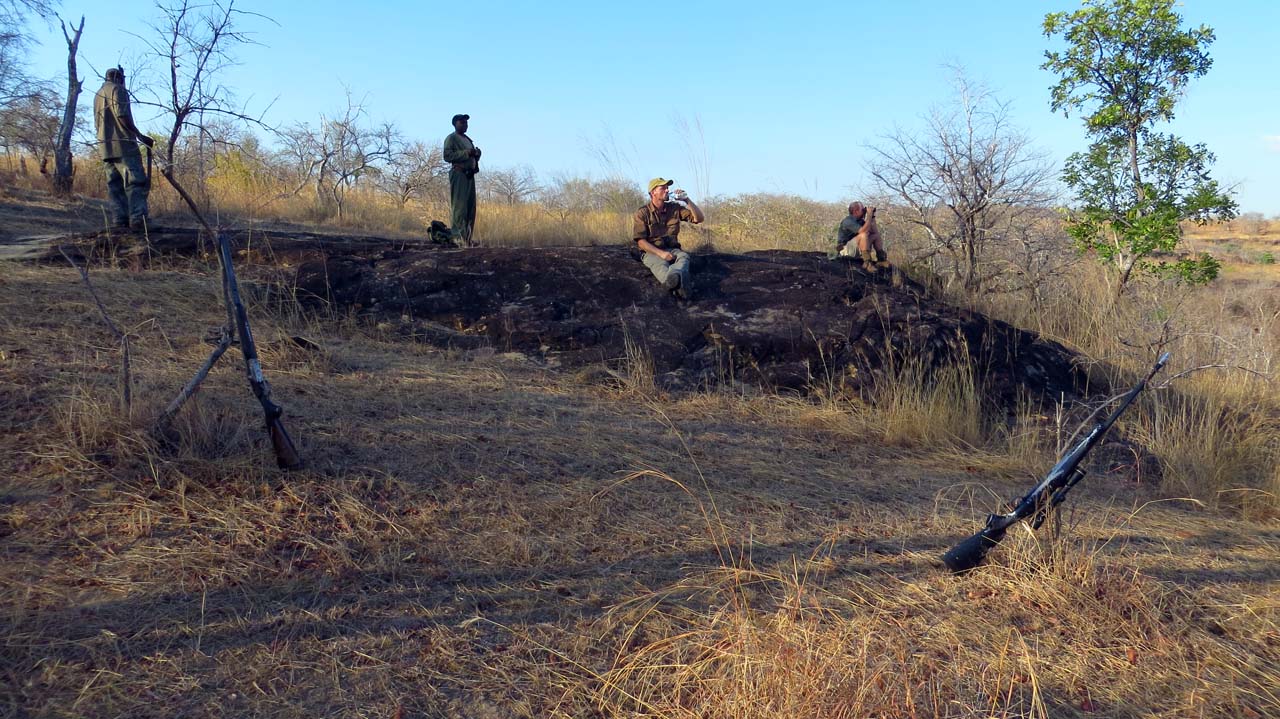 Some more near-max QuickLOADs, for the chambering carried by Staggerino above, are as follows: GSC HV 300-grainer: COL: 3.589" H4350 88.0 grains (99 % load) >>> 2823 fps @ 61,202 psi H4831-SC 94.0 grains (104 % compressed load) >>> 2780 fps @ 59,388 psi Barnes TSX 300-grainer: Short COL: 3.518" H4350 88.0 grains (99% load) >>> 2837 fps @ 63,772 psi Long COL: 3.743" H4350 91.7 grains (97% load) >>> 2861 fps @ 63,636 psi North Fork 300-grain Cup Point Expanding Solid: COL: 3.443" H4350 89.8 grains (101 % compressed load) >>> 2860 fps @ 63,632 psi Sierra GameKing 300-grainer: Short COL: 3.600" H4350 92.0 grains (97% load) >>> 2864 fps @ 63,462 psi H4831-SC 99.0 grains (103 % compressed load) >>> 2845 fps @ 62,886 psi Long COL: 3.641" H4350 92.0 grains (96% load) >>> 2850 fps @ 62,032 psi H4831-SC 100.0 grains (103 % compressed load) >>> 2858 fps @ 63,441 psi | |||
|
| one of us |
My starting loads on this side of the pond: 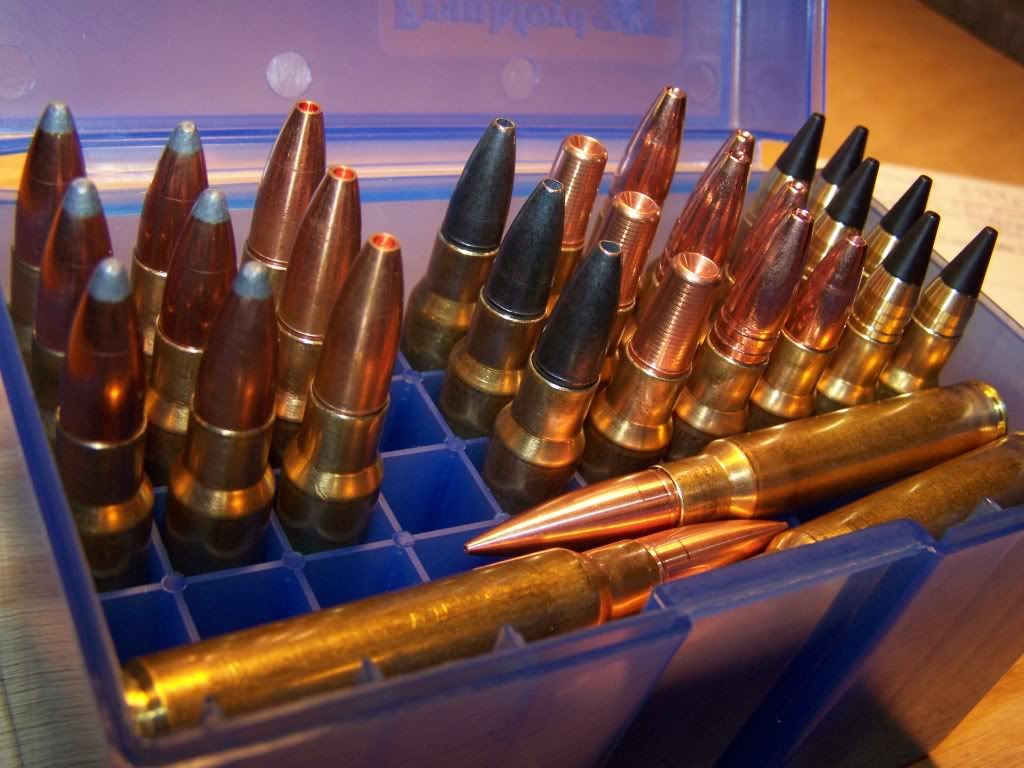 10 loads 3 shots each, all loaded with 85.0 grains of H4350 except the brass CEB 237-grainer, which got Varget 84.0 grains for the long COL, and 82.0 grains for the short COL. Daring, eh? Short and long loads with Barnes, Sierra, and the brass CEB. This is a test of how close the QuickLOAD comes to velocity estimation. Hopefully no garbage in, no garbage out. | |||
|
| one of us |
End of week one, today, of the 2012 .375/404 Jeffery Saeed Safari. I like this NO-BS cartridge picture, and the well worn, no-nonsense pair of rifles: 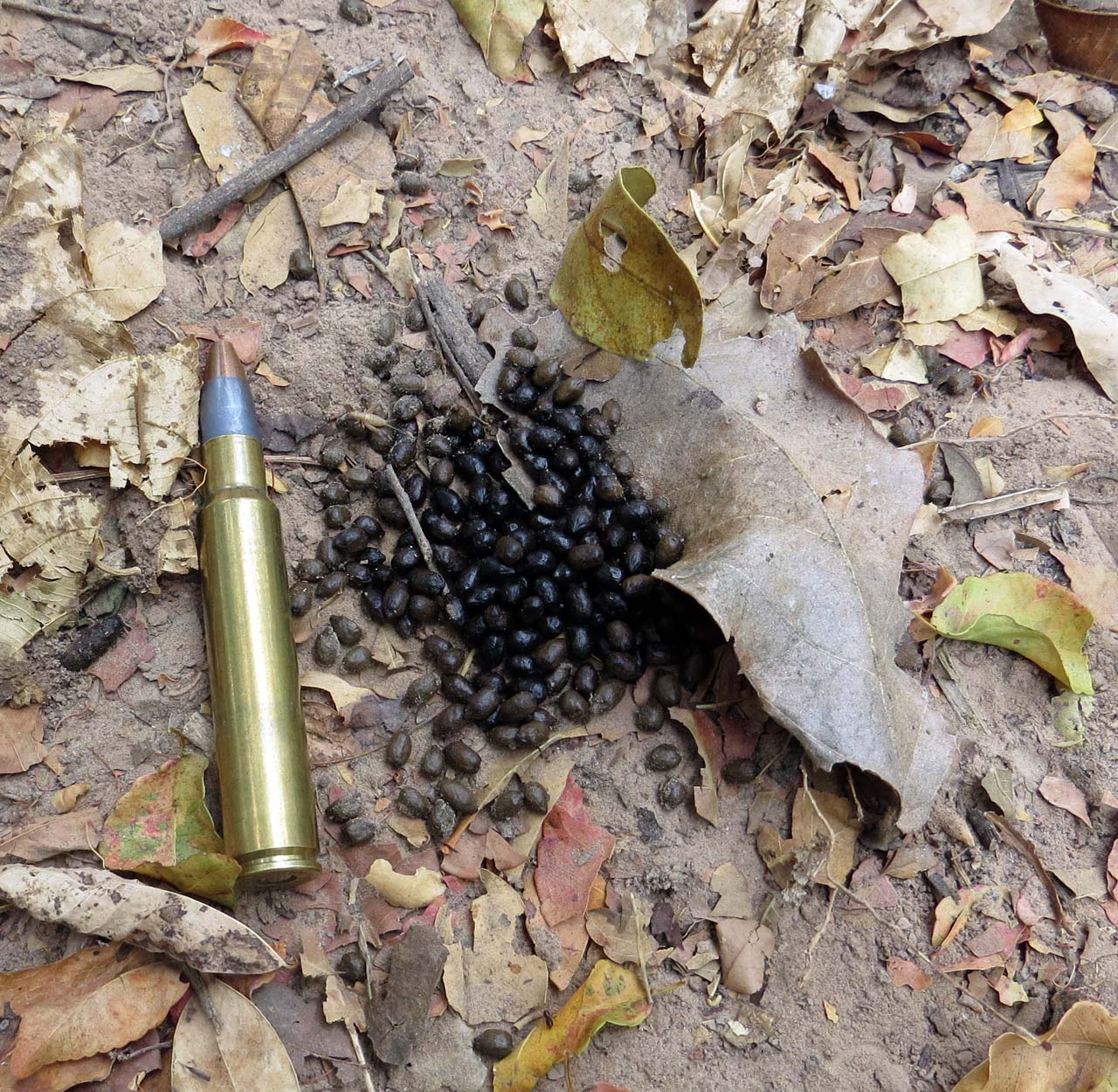 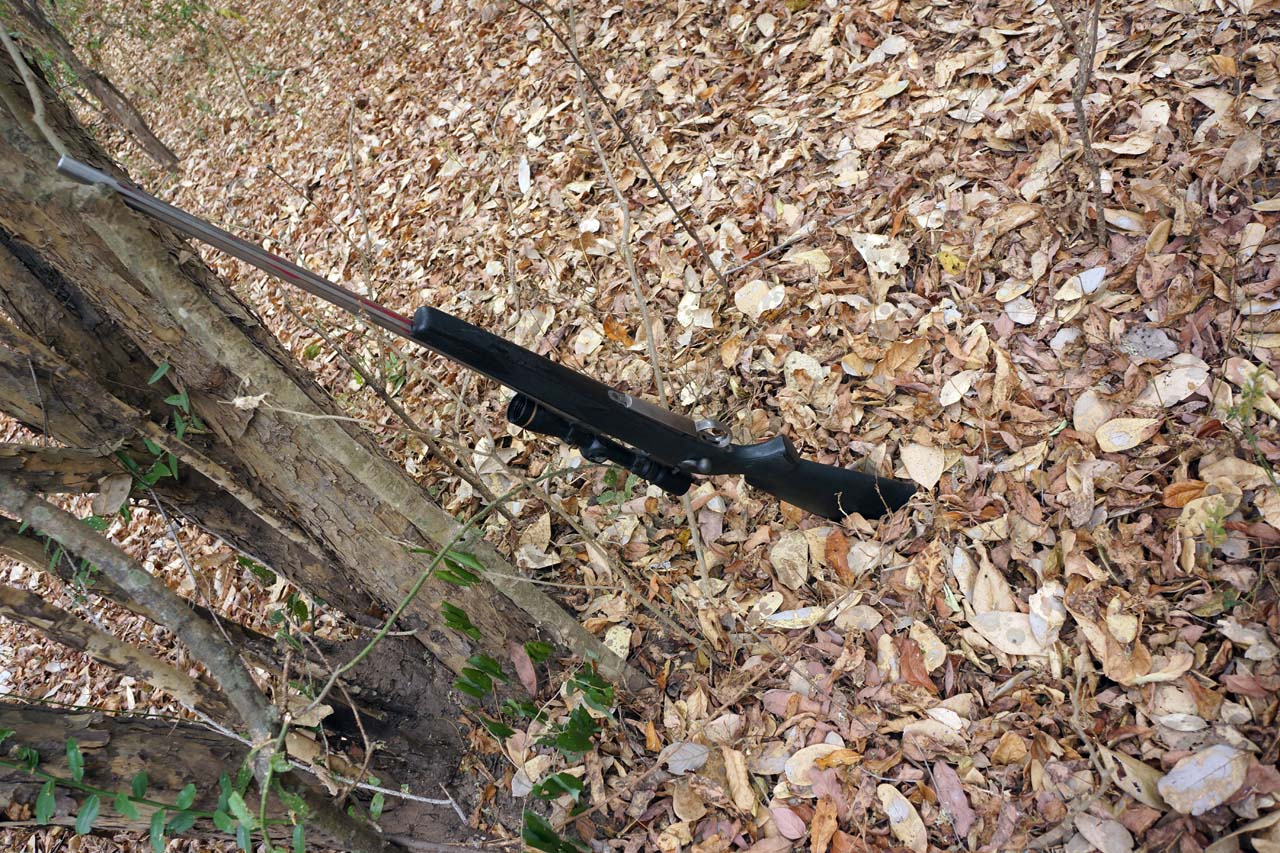 Below, today's buffalo, one-shot kill by the Walterhog from Saeed's .375/404. He must have plenty of buffalo permits available. But only three bagged this week. (The guy holding the .375/404 JS rifle is either Chris Stagg or Saeed. It's getting hard to tell the difference, but I think Saeed took this picture of his kill.) 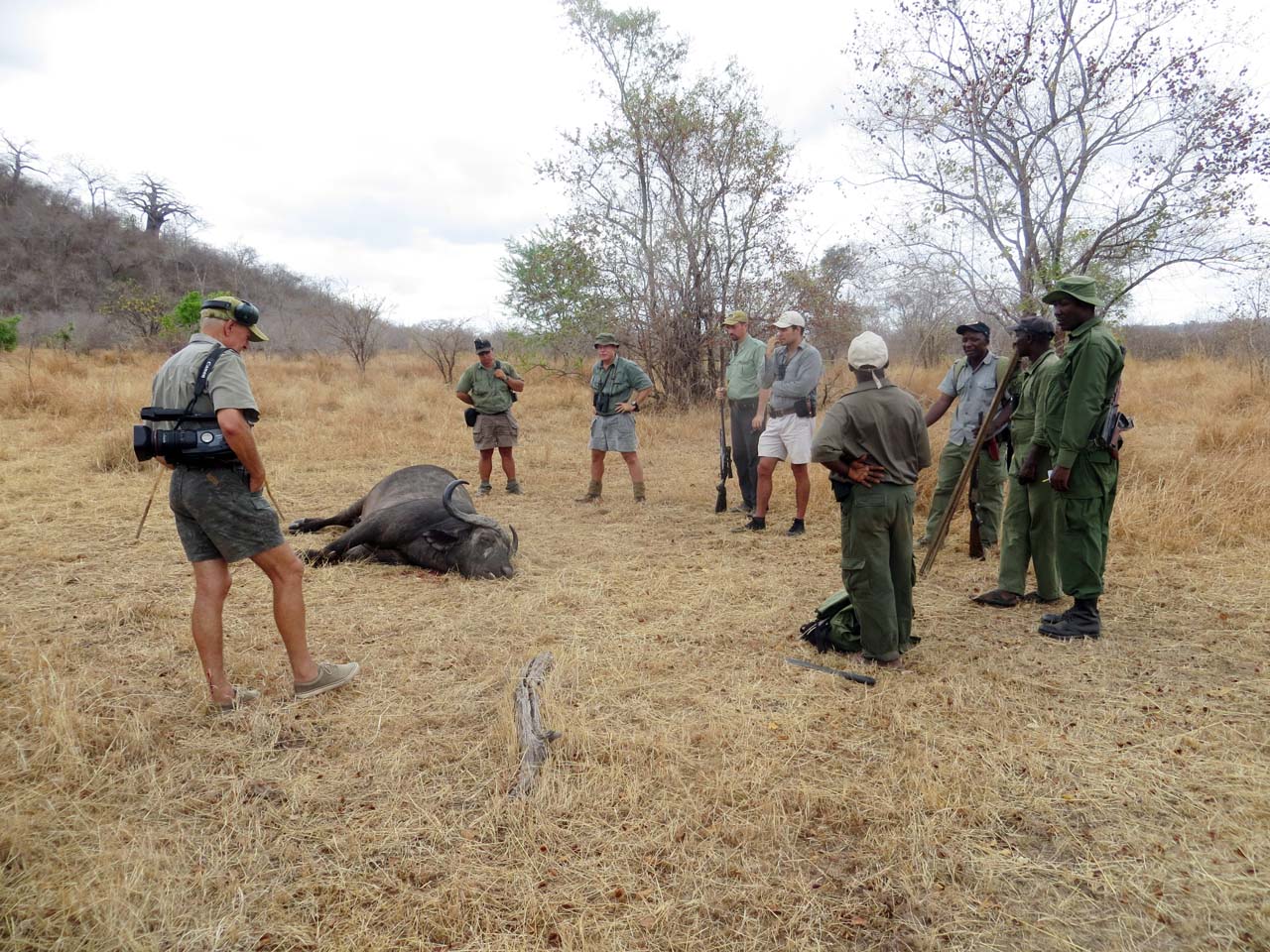 | |||
|
| one of us |
BC numbers available from makers, for quick reference: CEB MTH L01 320-grainer (G1 1000-yard tested): .830 CEB ESP L230 237-grainer (G1 250-yard tested): .345 GSC HV 300-grainer: .475 @ 3000 fps, .481 @ 2300 fps, .490 @ 1600 fps Sierra GK 300-grainer: .475 @ +2600 fps, .480 @ 2200-2600 fps, .470 @ 1800-2200 fps, .458 @ -1800 fps Barnes TSX-FB 300-grainer: .357 North Fork CPS 300-grainer: .??? Walterhog-Bridger 300-grainer: .??? 237gr SD = .241 300gr SD = .305 320gr SD = .325 | |||
|
| one of us |
The Hornady Custom dies for ".375/404 JS" work beautifully. That sliding bullet seater takes some getting use to, but it has got to be great for concentricity, and it even has a crimp in the right place to work with brass trimmed to 2.810" minimum. Now the YIKES!!! news. I had previously shot the smallest ever big-bore group of my life with a .375 Weatherby M70, and the Bridger copy of the Walterhog 300-grainer. The velocity obtained with that long-nosed bullet (too long to fit in the box of the M70 so it was single-shot loaded): 2717 fps Used RL-15 and had ejector marks on the headstamp face of the brass, so considered it excessive in pressure. Hence the bigger case capacity of the .375/404 JS and the longer box of my CZ. Well, it seems that in my Dan Lilja barrel with 1:12" twist and a .375Wby-type throat, if velocity is below about 2690 fps, these Bridger-Walterhogs TUMBLE, KEYHOLE LIKE CRAZY!!! That the minimal-bearing band structure (0.375" diameter and very skinny/sparse) may not be allowing my barrel to spin the bullet fast enough after a .3700"-long jump in a .3756"-diameter free-bore, is also a consideration. The 2717 fps 100-yard 3-shot group of the Bridger-made Walterhog in 375Wby rifle: 0.138" 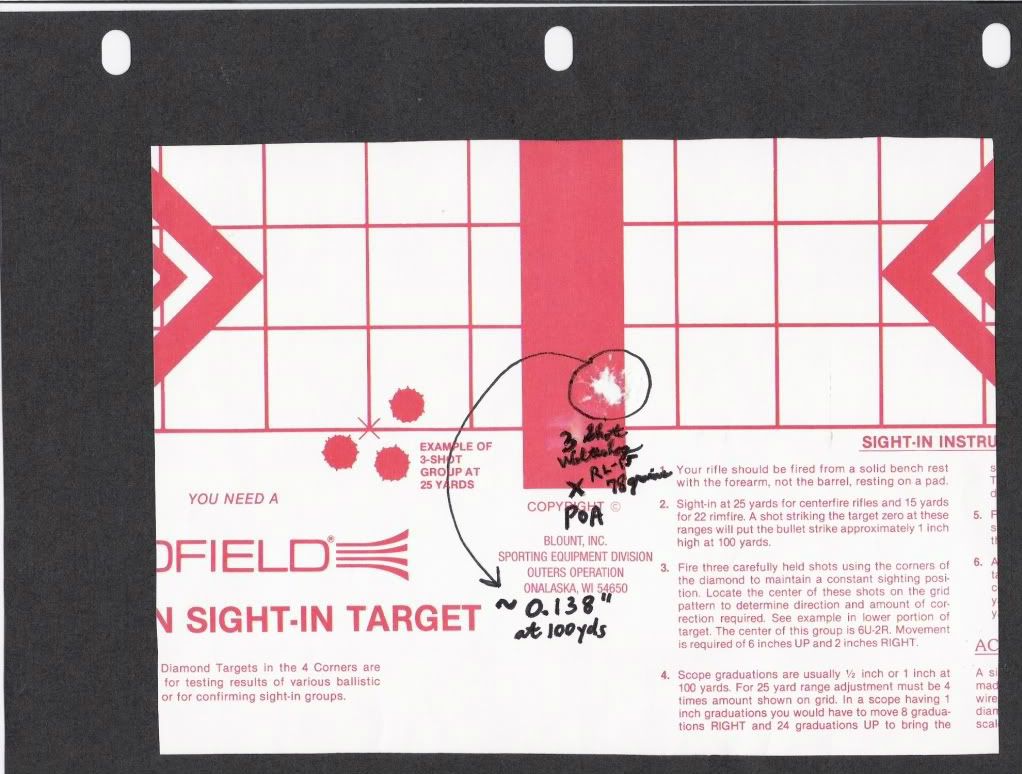 And now the slower velocity 50-yard 3-shot pattern of the Bridger-made Walterhog: about 11.5" POA was a 4-Corners-Center hold on 4 targets to get on paper first with a Sierra GameKing to foul the barrel. Then same POA to see where the Walterhogs hit. Walterhog No. 1 @ 2686 fps: keyhole Walterhog No. 2 @ 2659 fps: keyhole Walterhog No. 3 @ 2692 fps: no keyhole 2679 fps average for three shots, and 33 fps ES, and an extra-full choke pattern. 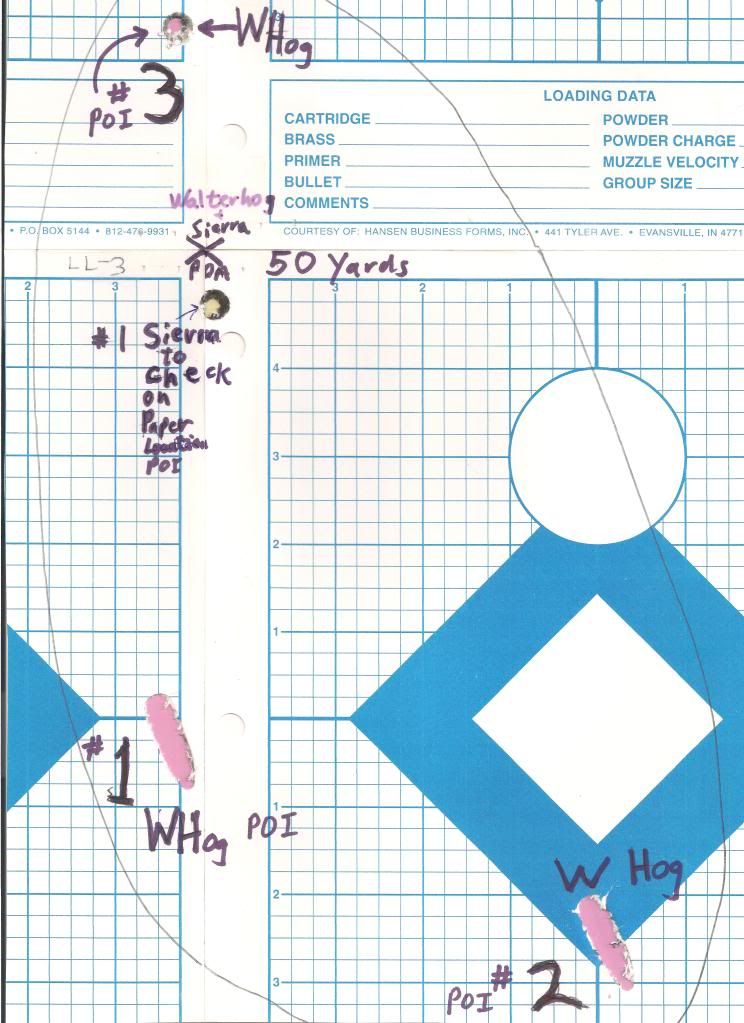 The initial accuracy champ is the GSC HV 300-grainer, with much more bandwidth bearing, and .376" diameter bands too. That bullet has to be loaded to a short COL of 3.590" because the driving bands won't fit in the narrow free-bore. This makes for a relatively short jump as is, good for accuracy. And the decreased case capacity by deep seating also gets the velocity up to 2699 fps, with same 85.0 grains of H4350 as used on the Walterhog: 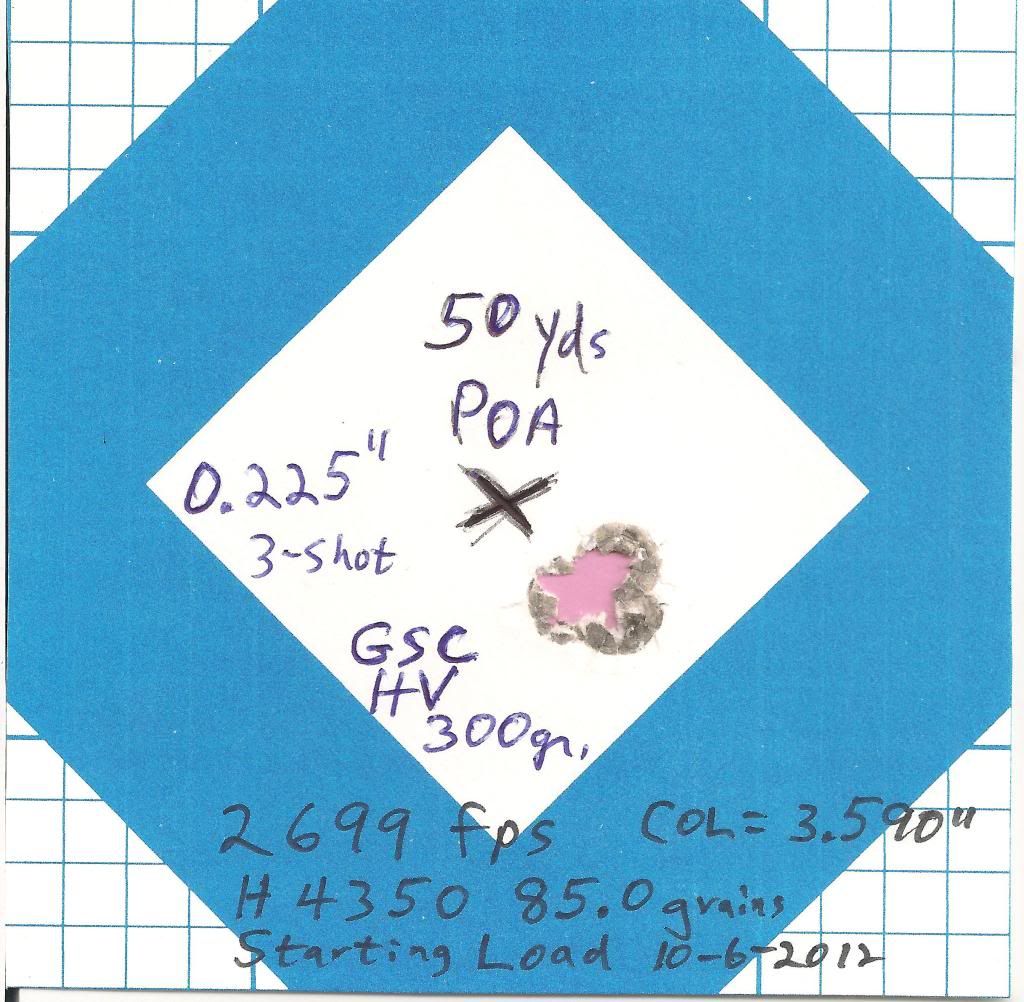 Honorable mention so far: Barnes TSX 300-grainer with COL of 3.750" gave better accuracy and less velocity than the same bullet loaded to 3.525". They actually are 0.375" diameter bullets, not the frequently undersized Barnes variety: 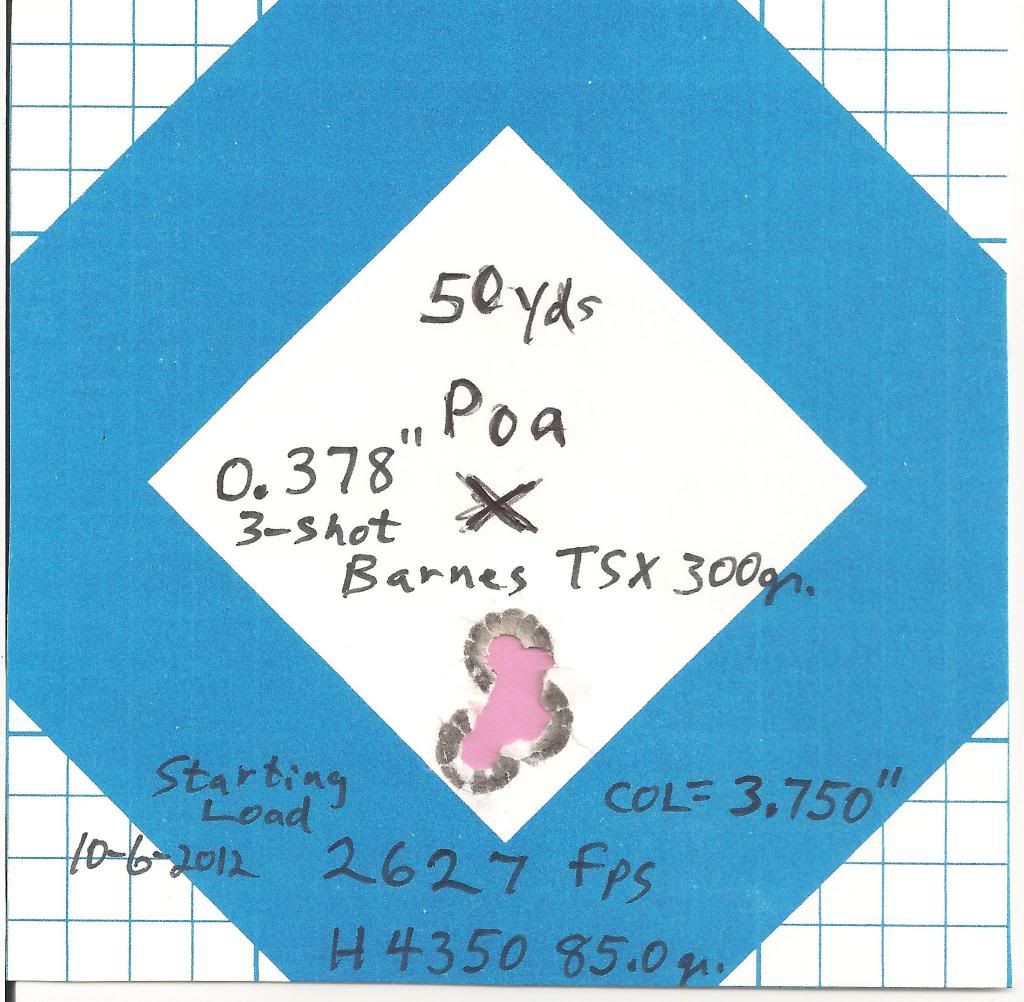  I think I am going to forget about the shorter-boxed Winchester for this cartridge, will stick with the CZ "Rigby-length" box, like on Saeed's Dakota-actioned rifles. This will be best for versatility with long nosed bullets, and even the Barnes TSX needs a 3.750" COL with the .375Wby (newest CIP spec) for best accuracy while optimizing other factors. Simply rebarrel a CZ 404 Jeffery to get outstanding feeding. A switch-barrel. Wondering what throat Saeed has on these two rifles: 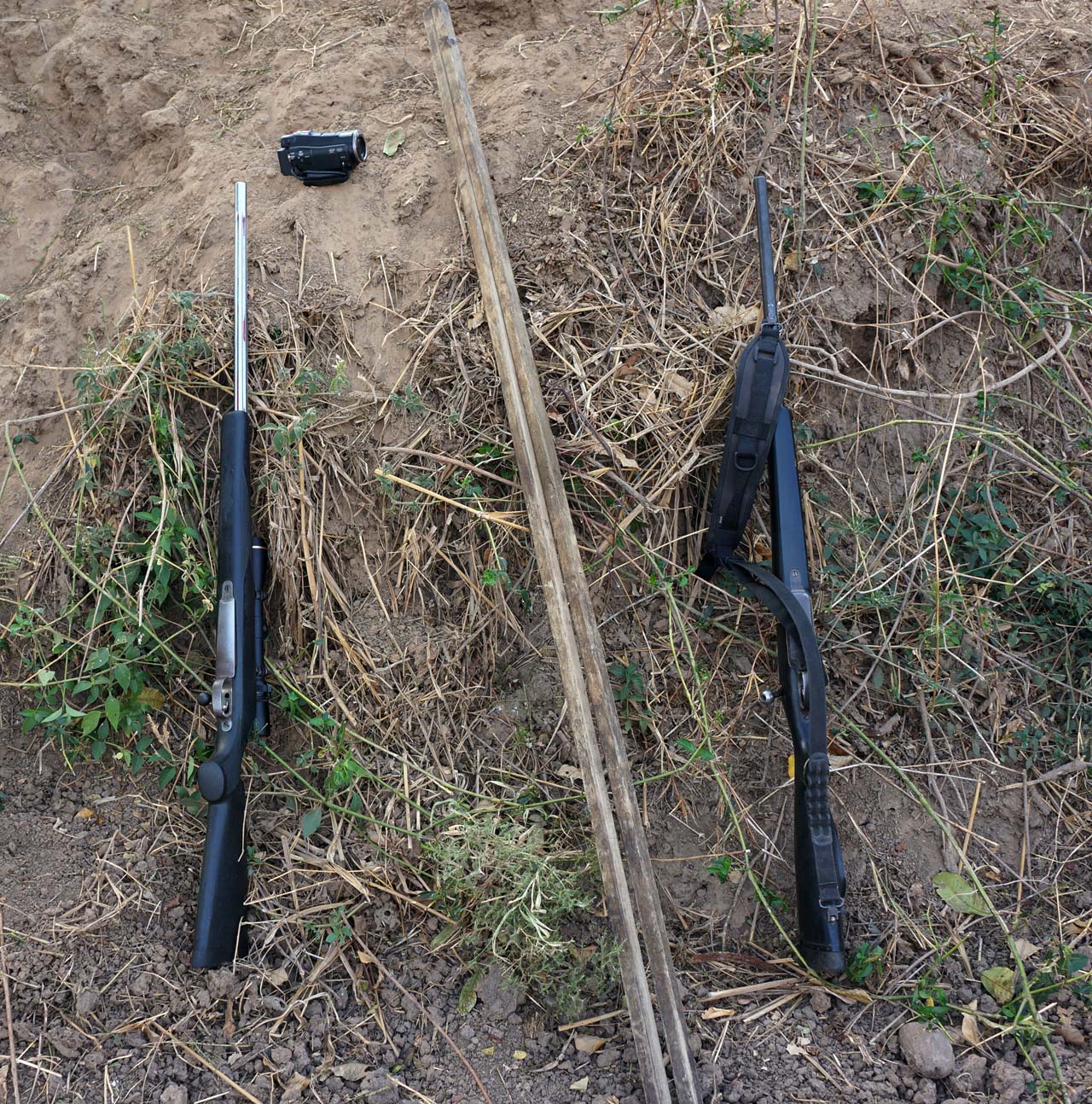 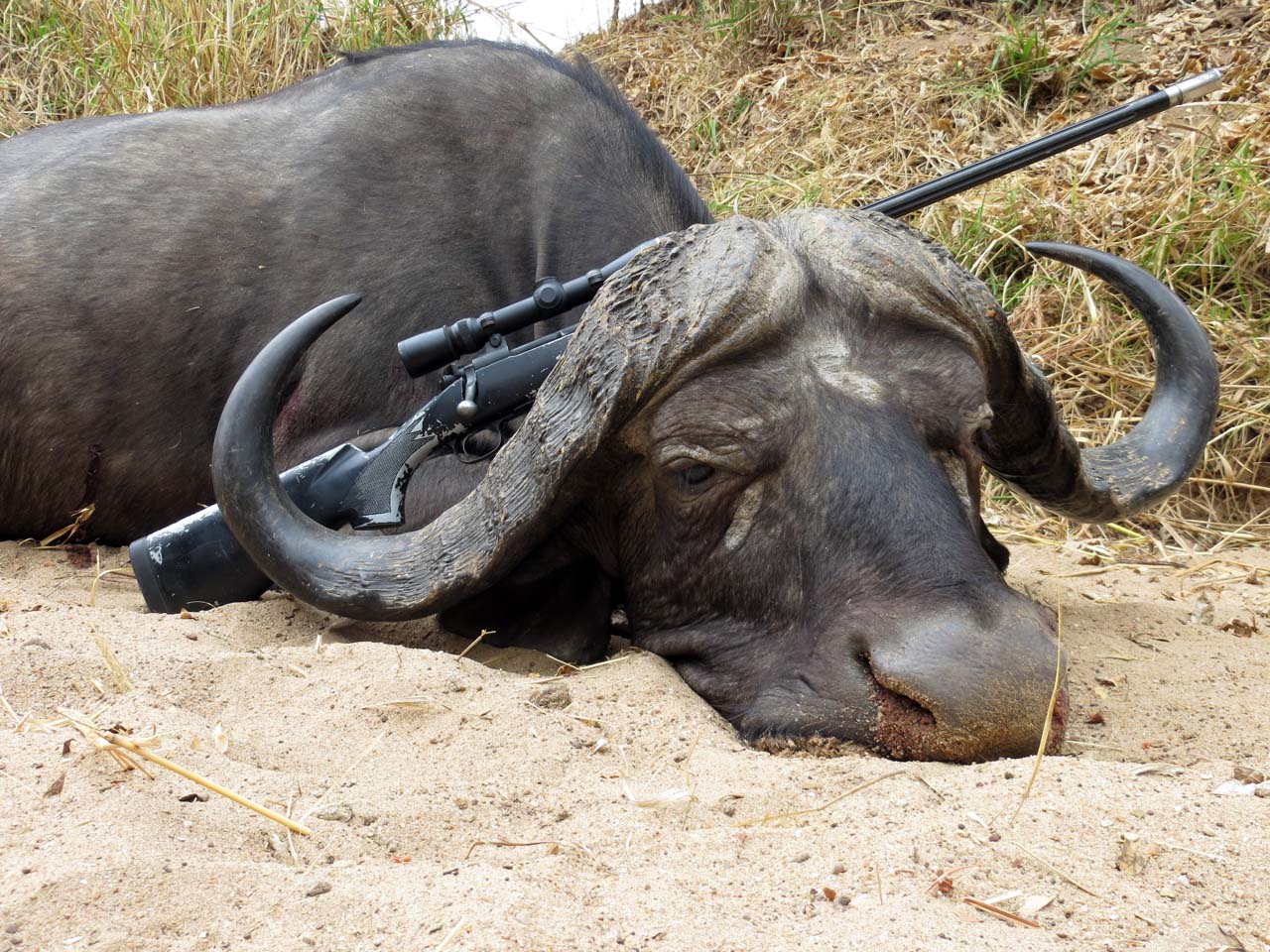 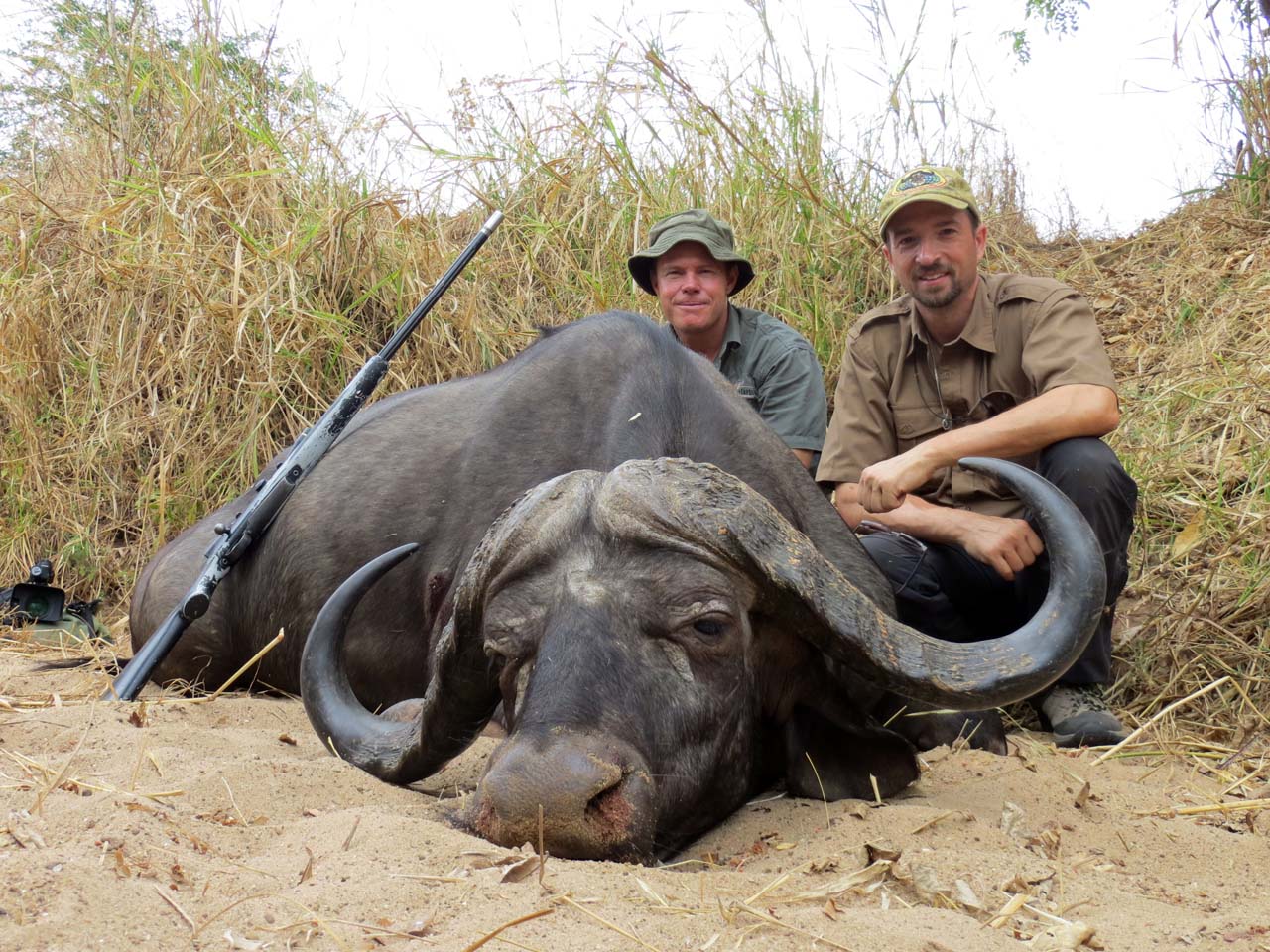 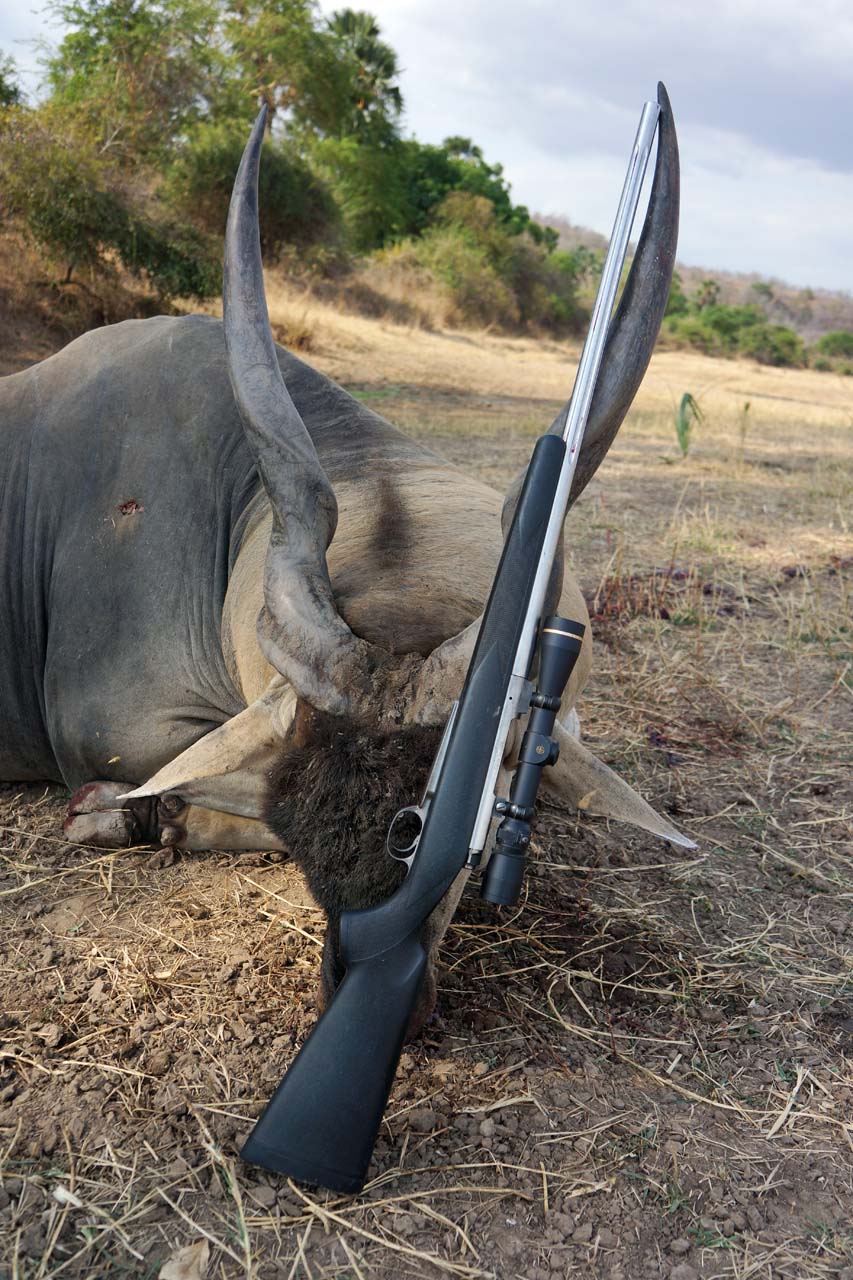 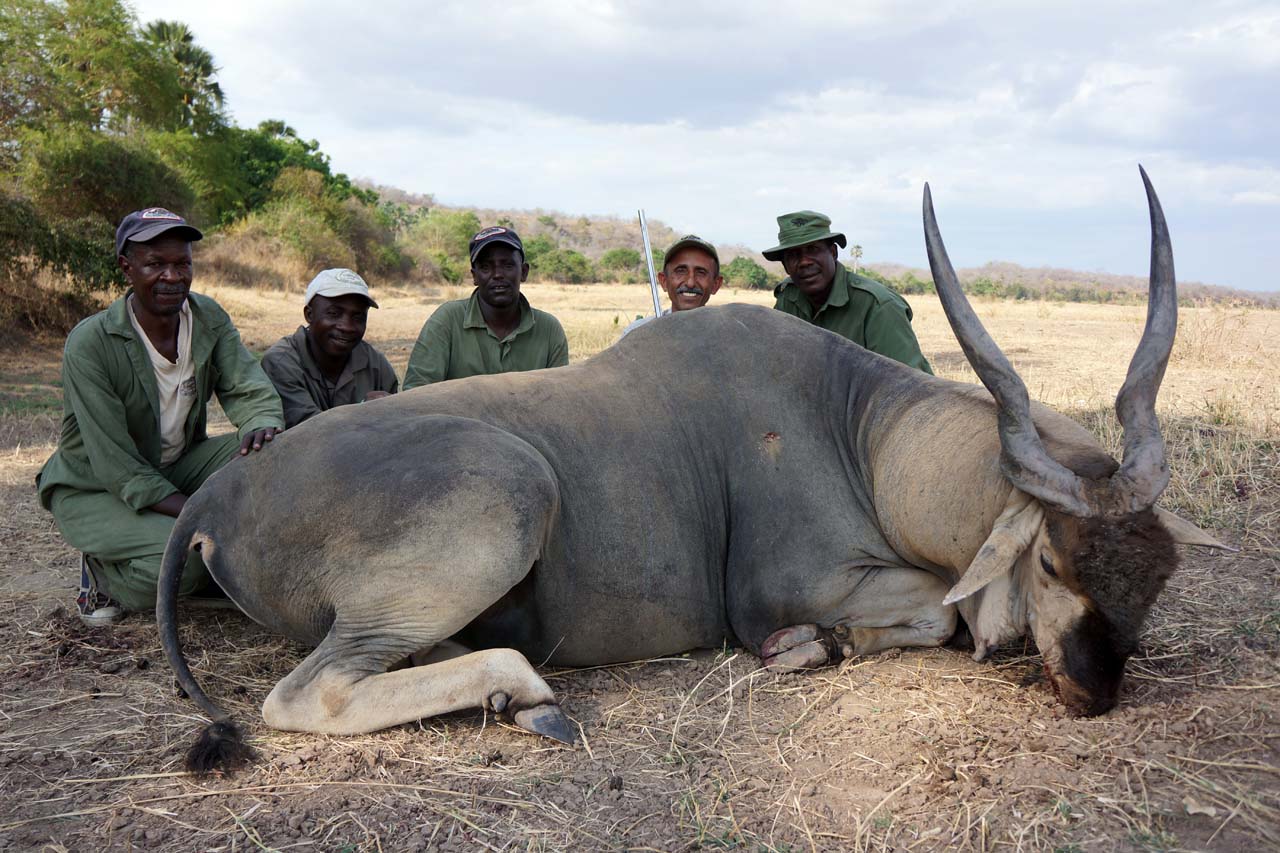 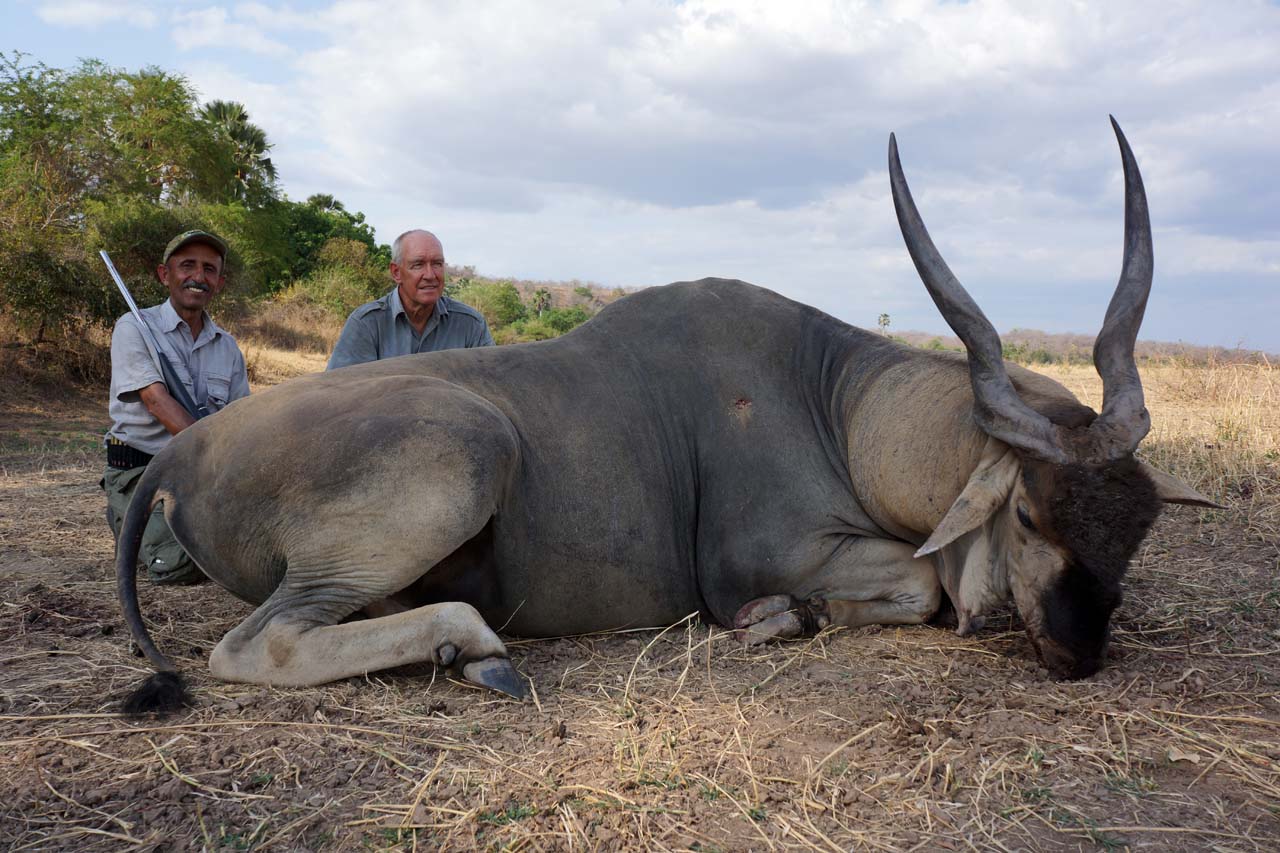 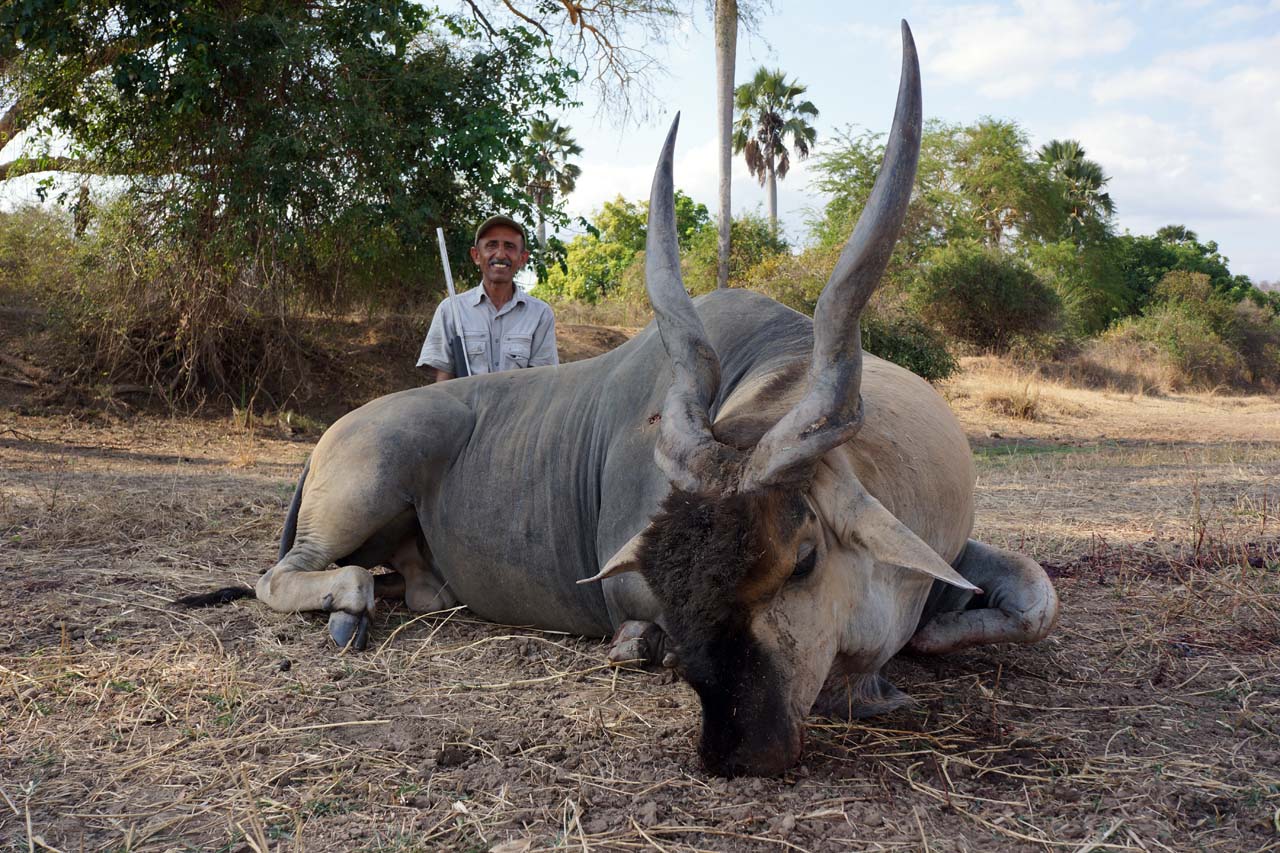 10-06-2012 action in Tanzania. | |||
|
One of Us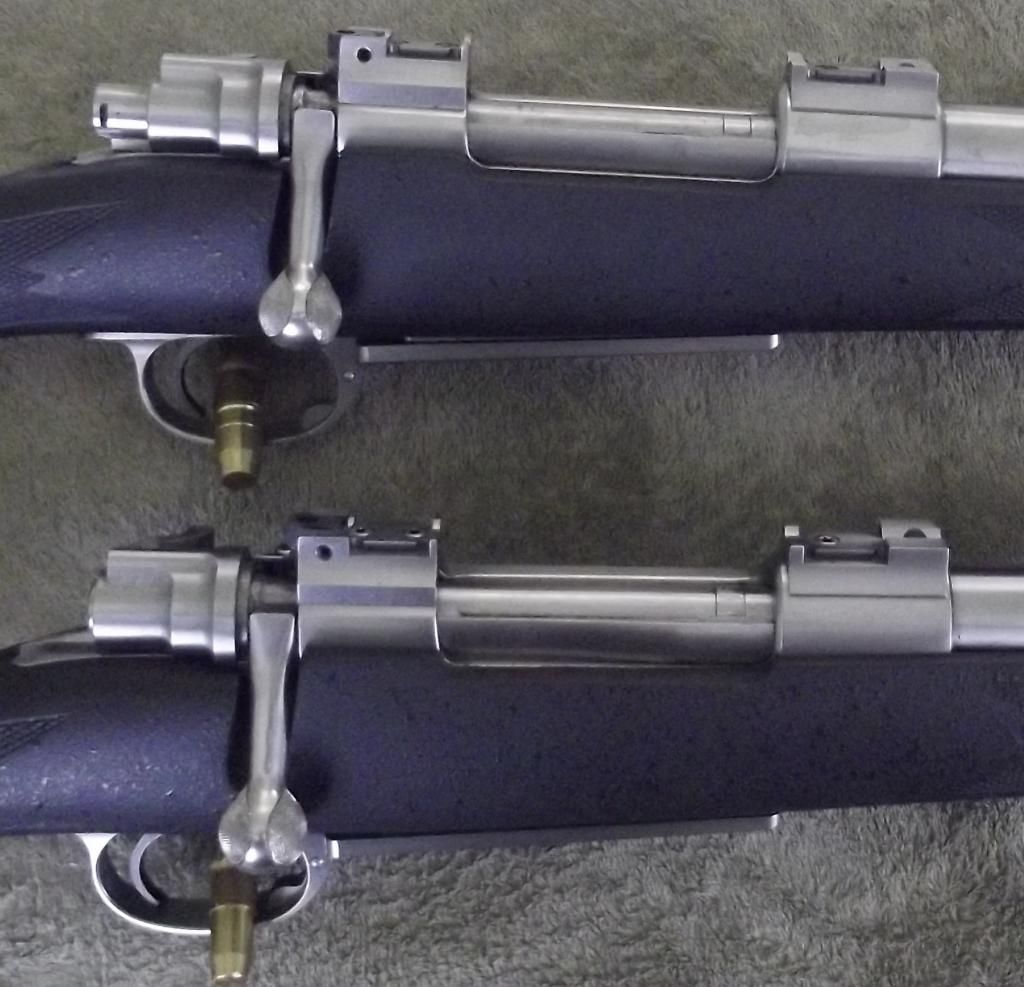 |
Ron, That’s most definitely an interesting issue you’ve encountered with the 300gr .375 Bridger ‘Walterhog’ bullet loaded to fit within the M70 magazine. For sake of discussion…I’ve tallyed up some of the data noted in the thread: Specified Chamber Length: 2.835” Specified Case Trim Length: 2.810” (although this was also noted as 2.820” early on) Neck Chamfer Height (aka: Chamber to Paralled-Sided Free Bore Diameter Length): 0.0162” Parallel-Sided Free Bore Length: 0.370” Paralled-Sided Free Bore Diameter: 0.3756” Leade Angle: 1º7’ Leade Length: 0.220” So this data gives (using the 2.810” case trim length): Length – Case Trim Length to junction of 0.3756” PS FB Diameter: 0.0412” Length – Case Trim Length to Junction Leade Angle: 0.4112” Length – Case Trim Length to 0.375” Diameter within Leade Angle: 0.4472” And what we know based upon your test work to date: 1) The 300gr GSC HV bullets had a ‘bullet jump’ of approximately 0.0012” before the 1st driving band encountered the angle of the Neck Chamfer commencing the swaging of the driving bands to match the 0.3756” diameter of the PS Free Bore. The resulting accuracy was a 0.225” bullet grouping at 50 yards. 2) The 300gr Barnes TSX bullets had a ‘bullet jump’ of approximately 0.1675” before the bullet ogive encountered the rifling at a diameter matching the .375” maximum diameter of the bullet. The resulting accuracy was a 0.378” bullet grouping at 50 yards. 3) The 300gr Bridger Walterhog bullets had a ‘bullet jump’ of approximately 0.4372” before the 1st driving band encountered the rifling at a diameter matching the .375” maximum diameter of the bullet. The resulting accuracy was an 11.5” bullet grouping at 50 yards. 4) The ‘bullet jump’ window is a 0.0012” minimum to a 0.1675” maximum for optimum accuracy. Of course, the only way to absolutely verify the above min-max ‘bullet jump’ accuracy window specification would be to: 1) Have Rusty do a chamber cast of the rifle used in this testing to verify the cut chamber to the finish chamber reamer specifications; and the barrel’s exact bore and groove dimensions. 2) Measure and identify the exact length of the bullet protrusion from the case mouth and that length measurement to the bullets intersection with the chambers’ throat dimensions for each of the three bullets listed. Once this information is verified, it will reveal is the ‘window specification’ of the monometal bullet’ banding required for optimum accuracy in a barrel chambered using this specific finish chamber reamer. Oops...it's time to go roost for the evening... Jim "Life's hard; it's harder if you're stupid" John Wayne | |||
|
| one of us |
Jim, Thanks for the thoughtful and "calculating" reply. Let me go through this with my reactive, reflex thoughts in red.
Jim, Now, my further thoughts in black: Truly, the exact dimensions of the throat we are talking about here are down to .0001" measurements, and a chamber cast is no good for measuring that well. No doubt there is some slop involved, but methinks that is not important. The exact same bullet that keyholed on two shots at sub-2690 fps, did not keyhole at 2692 fps (sample of three in the 375/404JS), BUT it shot a 0.138" 3-shot group at 100 yards when it averaged 2717 fps (sample of three in the 375WBY). All six of those exact same Bridger copies of the Walterhog had the same relationships to throat, same throating of the two different rifles. Same 1:12" twist. Same .375" grooves. But indeed different barrels with other factors unknown. Velocity was the only difference known, so far. So bullet factors are more suspect by me than rifle factors. Gerard has always impugned the 300-grain GSC HV as unstable at 375 H&H velocities, and indeed it is longer than the Walterhog of same weight. Gerard will grudgingly admit the 300-grain GSC HV is better at 378 Weatherby velocities closer to 3000 fps than to 2500 fps. Now, I am thinking that the .376" band diameter of the GSC HV and its greater bearing surface versus the .375" diameter skinny/sparse minimal bearing Walterhog must account for getting a better spin on the longer GSC HV, and better stability, or is it just that the greater velocity average of 2699 fps was enough to stabilize it? Maybe both are just barely stabilized at 2690 fps? Great for long range accuracy. Maybe not so great for transition from in-air to in-game. But Saeed has never had problems using his Walterhog in his most probably tighter throated original 375/404. But we can't go there, that throat is top secret. The Barnes TSX is actual .375" diameter and has a lot of bearing surface around those 5 cannelures along the bullet shank. It is stable at lower velocity of 2627 fps, but it is also a shorter bullet than either GSC HV or Walterhog, but can be loaded longer to get close enough to contact beginning in the leade. The GSC HV has to be loaded short, yet it is very close to beginning engagement in the PS-free-bore itself. The Walterhog has to be loaded long, but it still has farther to jump to begin contact in the leade than either the Barnes or GSC. Alas, I only have a few more of the Bridger-copied Walterhogs. Will shoot them at faster velocity, above was only the start. I have a feeling that all of the 300-grainers will get better at longer range, at higher speed. I know my throat selection is capable of good accuracy, and it will allow top velocity too. The common man's 300-grain Walterhog might best be (pick one) the GSC HV, Barnes TSX, or North Fork SS or PP softs. With the latter you get your choice FPS and CPS of same weight, 300 grains. With the GSC there is their excellent FN of 300-grain weight. With the Barnes TSX: use a CEB or other of above solids. Solids are only needed for elephant. Cheapest, best single bullet for all game except elephant: Barnes TSX-FB 300-grain Carry a few solids for the rare need. Then there is the matter of the 320 and 237-grainers from CEB. To be continued ... | |||
|
| one of us |
But first, the Bridger-Walterhog can be seated longer. A slight crimp between the nearly microscopic will leave three bearing bands inside the case neck, and get one of the .3750"-diameter bands to the verge of, or inside of, the .3756"-diameter PS-free-bore. This will increase COL to about 3.750" like with the Barnes TSX crimped on the third cannelure. Increases COL by 0.060". Increases effective/net case capacity, so even more powder will be needed to get velocity above 2700 fps. Goal is a mere 2750 fps and +5000 ft.lbs. with 300-grainer for all-purpose use. Hotrodders with high BC bullets may want to use higher velocities (and pressures). The 375/404 JS does .375 Weatherby work in the 50K pressure range instead of 60K. It does significantly more than a standard .375 H&H, and it does so with pressures significantly lower than the .375 H&H. What a numerologic pun: 3.75" COL for a .375 cartridge. What? Not as amusing to everybody else as it is to me? No further changes in COL of the GSC are possible. Nor are they needed, with demonstrated accuracy and room to add some more H4350. One seating depth fits all tight-diametered throats with that .376"-diametered monometal copper bullet. Saeed seats his Walterhog bullets deep, and does not crimp, but still requires a Rigby-length box, due to the long nose of the Walterhog bullet. I suspect that Saeed has one of those short-throated benchrest chambers since Dwight Scott, "Legendary Benchrest Gunsmith," was involved with Saeed on the design ... and neither one of them has the reamer spec sheet anymore, and the custom reamer maker, Mr. Green, has moved on with no forwarding address ... | |||
|
One of Us |
Hey Ron, Thanks for catching my comment on the 300gr Bridger Walterhog being seated to fit within the M70 magazine; that's what happens when one finally gets sleepy when you're about to hit the 'post button'. I'd already computed that the COAL with the Bridger seated to the upper driving band had to be >3.645" which eliminated magazine feeding. On my tally using the 0.025" difference between your 2.810" trim case length and the 2.835" chamber length in addition to the 'throat tally' length - my rational was that the upper band of the 300gr Bridger Walterhog still travels the length between the case mouth to the .375" junction of the leade minus the width of the driving band (which I swagged as 0.0150" in width). Anyway, right wrong or otherwise that was my rational. Much the same as my rational that the GSV HV bullet traveled an extremely short distance before it larger 0.376" diameter banding were swaged to 0.3756" diameter as they passed through the Neck Chamfer causing the bullet to stabilize within 0.3756" diameter PS Free Bore section of the throat before encountering the leade. And relative to the 300gr Barnes TSX, I swaged that there was approximately a 0.285" length of 0.375" diameter banding and bullet Ogive protruding from the case mouth which substantially reduced the 'bullet jump' of the TSX when compared to the Bridger Walterhog. So basically I was thinking that perhaps two additional bands spaced further towards the nose of the Bridger Walterhog bullet would sufficiently reduce the bullet jump within the M70 to eliminate the bullet instability at the slightly lower velocity while allowing it to be seated within a COAL to also fit within the M70 magazine. Anyway, that was my muddied thinking. Jim "Life's hard; it's harder if you're stupid" John Wayne | |||
|
| one of us |
Jim, That is good thinking, but I do not want to get any custom bullets made for the .375/404 JS. I am also thinking that Saeed may be on the verge of too little bearing surface with his minimally banded bullet. I do not want to copy that. The Walterhog may work best in a shortest possible throat. That long nose projection will certainly fit a "zero-free-bore" rifle. The customary chamber neck length plus-tolerance beyond max brass length, plus neck chamfer, plus trimming of brass properly, will certainly accommodate the skinny first band if it is sticking out beyond the case mouth. There will still be some jump to engagement of a leade-only throat with zero PS-free-bore. But for use of the greatest variety of bullets, and some case capacity benefits, and some pressure benefits, some free-bore helps, overall, IMHO. And even the Walterhog works in my free-bore if velocity is high enough. My PS-free-bore is just under a caliber in length and only 0.0006" greater diameter than caliber. It is wider than it is long, but it is as tight a width as practically possible. Not too sloppy to work well, methinks. Another goal: Shoot all available 300-grain softs to about 2" high at 100 yards, and all available 300-grain solids to dead on at 100 yards. We have many choices in 300-grain bullets for the .375. Bullets lighter or heavier than 300 grains in .375-caliber are still considered "experimental" unless used strictly for varmint work. | |||
|
One of Us |
Ron, Just had a chance to log back in and thought I’d re-read the entire thread before answering your last post. I certainly understand this; I felt the pocket book hit when I ordered the custom MTH bullets in .423 and .500 calibers. But, the Barnes TSX bullets in .423 caliber are their typical undersized offering and I didn’t need a 400gr TSX bullet for my purposes in that caliber, and there was nothing offered in .500 caliber – so custom order was required for both. Regarding the bearing surface of the Walterhog, that might be true except that Walterhog #3 flew true at 2692 fps MV while #1 and #2 key-holed at a slightly lower MV… I personally believe that what we’re facing here is to high of a MV requirement to stabilize the Walterhog with the throat specification of your Manson finish chamber reamer. As an example, here are the PS Free Bore specifications for some other modern designed .375 caliber chambering’s: .375 Blazer = 0.1025” .375 Dakota = 0.1025” .375 Ruger = 0.1250” .375 RUM = 0.1753” Personally – using hindsight – I perceive that the .375/404 JS would have been better served with a Parallel-Sided Free Bore of 0.125” minimum to 0.195” maximum… But just as we did when computing the max-PS FB for max-accuracy for the 500 AR Nyati finish chamber reamer – take a thin permanent marking pen and mark one of the 300gr .375 Barnes TSX bullets with the last point on the bullet nearest the ogive that is .375” in diameter and a second mark at the last point on the bullet nearest the ogive that is your Lilja barrel’s bore diameter. Transfer the markings to one of your loaded .375/404 JS rounds with the TSX bullets, COAL designed for your CZ magazine, and then measure how much .375 caliber bullet protrusion exists – add the Barnes recommended 0.050” to that measurement, and that’s your target maximum PS FB with monometal bullets… I believe that the Sierra 300gr bullet will also work within that PS FB specification. If you do this I’m going to make a jump here and state that it’ll be less than the 0.195” noted above – very likely much closer to the .375 Ruger PS FB spec than the .375 RUM PS FB spec. Now off to another subject - Regarding the 300gr .375 GSC HV bullets… I agree that the 300gr .375 GSC HV bullets are the closest ‘off the shelf’ commercially available bullets to Saeed’s 300gr Walterhog bullets. But, looking back on page one, I noticed that the shank diameter of some HV bullets may be larger than the bore diameter of barrel – photograph from the GSC website:  and you’ve already noted that 300gr .375 caliber GSC HV bullet’s band diameter is .376” – 0.0004” larger in diameter than the .375/404 JS finish chamber reamer PS FB specification. So besides having to be critical if the band diameter of the GSC HV bullets one must also be critical of their shank diameter as well; because it makes zero sense to use a ‘bore-riding bullet’ that is oversize in both band and shank diameters. 300gr .375 CEB MTH bullets… I guess it’s not hard to imagine why Dan doesn’t offer a 300gr .375 MTH bullet that is designed with a shorter protrusion to function within the CZ magnum length magazine – though I guess the only factory chambering that would match that need is the .375 H&H. Anyway, if CEB did I believe it would have a .540 to .600 BC when the design was finished. Just food for thought… And then… I reckon one you’ve perfected the throat specifications of the .375/404 JS with the bullets that you’ll primarily be using - you could always have Manson modify your reamer – then have Rusty set the barrel back sufficient to eliminate the excess PS FB while re-aligning the barrel markings, and then re-cut the chamber… And since you’re using a synthetic stock, it’s an easy fix by re-bedding the barrel section of the stock. Anyway, that’s my musings for the time being… Oh geez…just noticed I missed one of your posts before my last response – I’m off to my grandson’s baseball game so I’ll have to wait until I return to pay attention to it… Jim "Life's hard; it's harder if you're stupid" John Wayne | |||
|
| one of us |
Jim, I was already thinking about getting Manson to re-grind the throat section of my reamer, keeping the same tight diameter and cutting the length of PS-free-bore down to 1/2 caliber or less. As suggested, will first do some "tooling around" with a "throat gage." Also, seating a long bullet with a sharply square flat base backwards can produce an accurate enough "go gage" for throat, for my purposes, blackening the corner edge of the flat base with a Sharpie, to aid in detecting minimal contact in the leade of throat Will continue the "long COL" load development. This rifle will keep the .375 Weatherby throat for its long magazine, and use with non-Walterhog bullets. The possibility of an M70 .375/404 JS is back on again. Short throat, short COL, 3.6" magazine box. The 404 Jeffery African Sheep Rifle could get a switch-barrel of .375-caliber spec. 1:10" twist from Pac-Nor, if it ever passes QC, on the second go-round. It won't be able to magazine-feed Walterhogs (or MTHs), except as single-shot loading off the top, but will do well with all other .375 bullets, and be more accurate with the Walterhog and MTH as single-shot, possibly. I still have no gripes with the .375 Wby CIP throat of 2001 spec. | |||
|
| one of us |
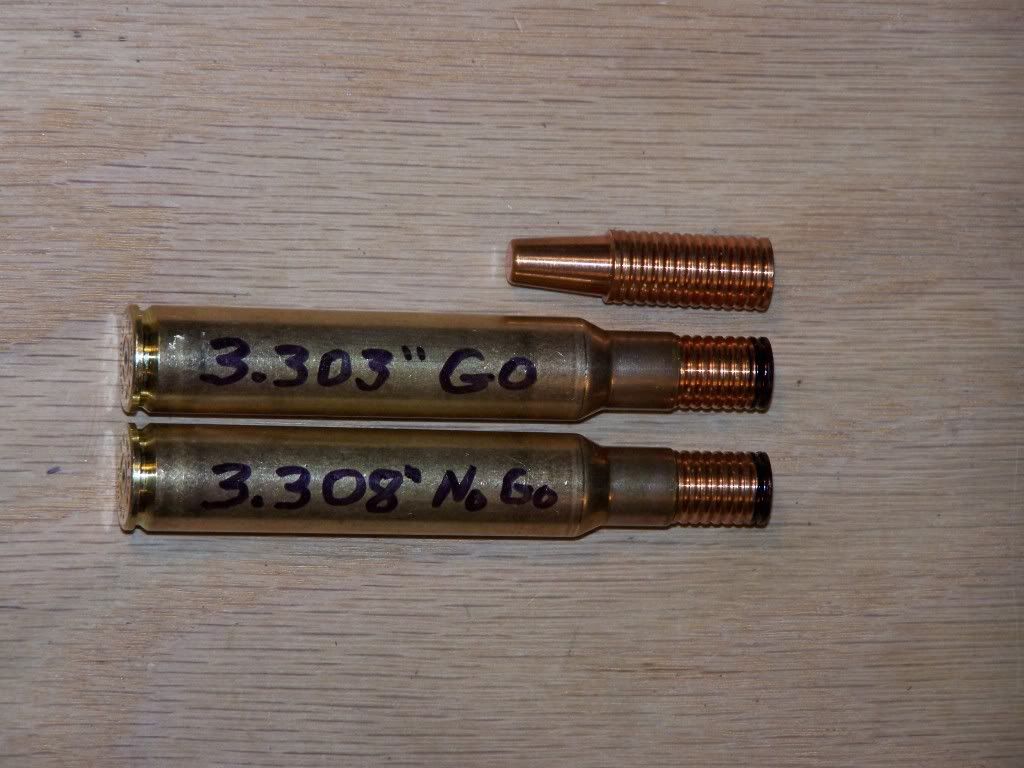 Jim, Here is how I do it when I have questions about slop built into a rifle throat: A sample of "Groove" brand "MI" bullets. I don't think they are still in business. Too bad. They made great free-bore gages. This one is a monometal copper .375"/265-grain "rebated truncated cone" FN solid. Nice sharp leading edge at the front. Cuts a nice round hole in the hide going in. "Maximum Impact" MI bullet by Groove. The flat base edge on this bullet is pretty sharp too, but I can't draw blood with it, nor cut my hide. Might have the edge "broken" just enough to dull it. The bands all the way to the base are true .375" diameter. So projection beyond 2.810" minimum brass length to hit the leade at .375" diameter is very close to between 3.303" - 2.810" = .493" and 3.308" - 2.810" = .498" or .4955" +/- .0025" so call it .496" Subtract the recommended .050" off throat contact for Barnes: .496" - .050" = .446" So that is about 0.446" of parallel-sided bullet shank on the TSX that I can hang out front. Good to know for .375 Weatherby shooters that have the "proper" new (2001) throat. | |||
|
| one of us |
Hey! I could order a .375" Lee Bullet Sizer for 20 or 30 bucks and then could long-load the plus-sized GSC bullets too. I wonder if that would increase or decrease GSC accuracy. Deja vu. First .510-caliber, now .375-caliber. Dummies coming up. I could push a Walterhog through a .375" Lee Bullet Sizer with my pinky, if not gravity alone. No press needed. No lube needed. | |||
|
One of Us |
Ron, Those MI bullets by Groove are pretty neat and a darn good way to identify exactly how much total distance there is between the case trim length and the junction of the groove diameter within the leade. I think we need an acronym for this – so how about CTL/JLGD length. And it’s a darn sight easier to measure the CTL/JLGD length than to go through the gyrations that I did. Anyway, is there any chance you could get one or two of those Groove’ MI bullets to Saeed so that he could do the same Go/No Go within his .375/404 JS Dwight Scott’ (Dan Green finish chamber reamer mfg.) chambered rifle? I agree that his throat dimensions are likely tuned to maximize accuracy with the 300gr Walterhog – but maybe the PS FB was set for use with a different bullet. I agree with you – definitely order one of these Lee Bullet Sizing Dies in .375” diameter for use with the 300gr .375 GSC HV bullets. At least then you’ll be able to seat those bullets out to the maximum 3.750” COAL… Short night tonight – I’m off to roost… Jim "Life's hard; it's harder if you're stupid" John Wayne | |||
|
| one of us |
Jim, How about something simpler like "Effective Free Bore" or EFB Length. The minimum brass length would have to be assumed/understood in the definition of EFB Length. Length is understood too. Just call it EFB. Easier than typing "CTL/JLGD Length." EFB does not describe the free-bore diameter nor leade angle, but is good for "total jump." BTW, the Hornady dies must be terrific, as I did not scrape any black marker off of the MI bullet bases while passing them through the .3756" diameter Parallel-Sided free-bore of my rifle. We shan't trouble Saeed about his rifle throat specs until he is back from Tanzania. Saeed can make his own Groove MI throat gage or something better, I am sure. | |||
|
| one of us |
Some skidding of bullets on the lands? These just in from Tanzania, performed admirably on cape buffalo, latest make of .375/300-grain Walterhog: 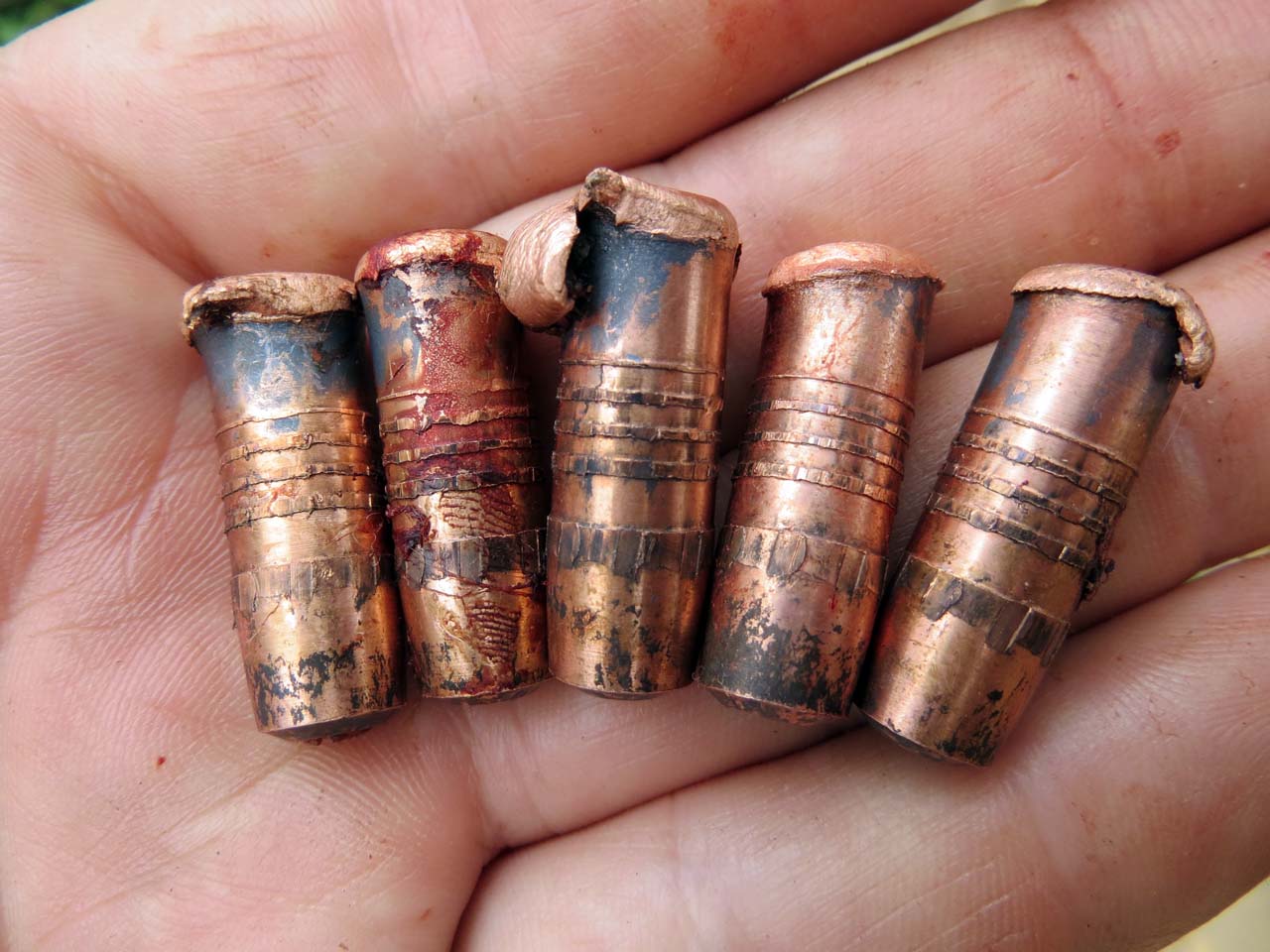 The bands on the "Real Walterhog" of current make do look a bit more robust than the ones on the old Bridger copy. Saeed has tweaked his hollowpoint specs and maybe the boattail along the way. When he made the hollowpoint bigger he had to add back the lost weight somewhere. He might have added some in the drive bands too. Old skinnier-banded Walterhog copy in middle below:  | |||
|
One of Us |
Ron, EFB works for me! Added to the book of definations: EFB: Effective Free Boreis the total distance between the case trim length and the junction of the groove diameter within the leade. It does not describe the free-bore diameter nor leade angle, but is good for "total jump." Humm...very interesting photographs. The bullets obviously work… But the very thin upper band appears to be abraded while rifling can clearly be identified beginning the 2nd band. It also appears the 4th band is slightly thicker than the 2nd and 3rd bands. I'm thinking the 1st band is just to thin to allow it to fully engage the rifling without abrading. My 2¢ worth of comments: 1) Use the 4th band width (thickness) for the 1st (upper) band which should allow it to engage the rifling without abrading. 2) Size bands 2, 3, and 4 the width (thickness) of the current 2nd and 3rd bands. 3) The 5th (base band) could likely provide the same chamber sealing and stability capabilities and benefits with half the engraving width; a side benefit would be to slightly reduce the bullet induced barrel pressure as well. Flipside to leave it as is... Overall, I believe the banding width of the NF bullets is about optimum as they appear to fully engage the rifling without abrading, they are sufficient in number to provide multiple bullet seating options while maintaining good neck tension, and they are sufficiently narrow to afford reduced bullet pressure within the barrel. Ok...my 2¢ are off… Jim "Life's hard; it's harder if you're stupid" John Wayne | |||
|
One of Us |
Ok 2¢ are back on… Rethinking the current production 300gr .375 Walterhog bullets… Obviously they work as currently machined. I thinking the very thin upper band may only serve as a neck crimp point with it being the 1st point of rifling engagement as a secondary consideration. It would definitely be nice to know what the group size these bullets afford from Saeed’s rifles at 100yds… Also would be nice to know the throat specifications for his rifles… Perhaps once he returns from his hunting trip and has the time… Ok…2¢ back off… Jim "Life's hard; it's harder if you're stupid" John Wayne | |||
|
| one of us |
Jim, More good thoughts, thanks. Overall I have to say I also like the North Fork banding best, including the true driving bands of the FPS, CPS, and the "grooving" of the SS, PP, and FP soft point bullets. Look at the rifling engraving going out onto the smooth-sided nose portion as well as all that banding along the shank on this .375/300-gr SS: ".375/404 Jeffery Saeed North Fork of 2012" in a 3.8" magazine box  Will order some of these to try. Should be optimum, and a true .375" diameter, not requiring resizing with Lee Bullet sizer. From North Fork site: Quick Overview If the job positively needs to get done, this is the one to do it. Thicker construction of the nose provides a slight delay of the expansion to allow penetration of heavy bone and hide. It is the best choice for the large bears or the heavy game of Africa. Even though it is built for the heavier animals, it will still open on the lighter species in Africa. It may not be the perfect bullet for impala sized game, but it will work and simplifies the hunt, one bullet for everything. The bottom photo is of a 375-285, which has been discontinued in favor of the 300 grain. The bullet was loaded rather anemically, at around 2300fps in deference to the unknown strength and quality of the borrowed 375 H&H rifle. The bullet was recovered from an Asiatic water buffalo. The bullet shattered the near side shoulder (it was videotaped and he couldn’t put any weight on it) and was found under the hide of the off side shoulder. | |||
|
One of Us |
Hey Ron, LOL – I have plenty of ideas, just not all of them will stick! I prefer the driving bands of the CPS and FPS bullets. The SS banding is nice and it most definitely is a great bonded bullet. My only comment is the extent of the engraving in the smooth sided nose portion of the bullet substantially adds to the pressure the bullet exerts upon the barrel especially when first engraved as well as being a substantial amount of surface drag as it passes down the barrel. It would truly be nice if the NF SS bullets were redesigned to be fully bore riding, as are the CPS and FPS bullets, but unfortunately the cost of new die sets is extremely expensive so it would take a major infusion of money – or magnanimous donors for caliber/bullet weight specific die sets, to convert the full line of SS bullets. That said, the NF SS bullets are So I think we have the optimum solution in .500 caliber for copper construction bullets – the 430gr CEB MTH paired with the new generation 450gr NF FPS! Thanks for that idea… Jim "Life's hard; it's harder if you're stupid" John Wayne | |||
|
| one of us |
Jim, Yep, maybe I better stick with the straight copper. News flash: GSC .376" diameter bullets fit easily into my supposed .3756" diameter free-bore with ease, and the only sign of contact is some bright spots on the bands. Well! The reamer specs are a "minimum" and that includes tolerances of: diameters: +.001"/-.000" lengths: +.005"/-.000" My throat might be .3756" to .3766" in diameter, and still be in spec. No, I don't plan to do a chamber cast of throat. But I might make a lead slug of the throat, a la the method of Veral Smith of LBT. Maybe the .375/300gr GSC HV is the perfect "Walterhog" for this .375/404 JS of 2012 with a .375 Wby throat. The first 3 shots with starting load gave sub 0.5 MOA and 2699 fps, with 85 grains of H4350, so I figure getting it to 2750 fps with accuracy will be no problem, especially with a COL of 3.755" or more in my throat. This bullet is self centering in this throat. No way to go wrong, as long as the bands are not too skimpy. These Hornady dies make ammo that good. Minimal run-out.   I'll use the odd .375 bullets of other than 300-grain weight for other .375s. The .375/404 JS will stick to a diet of 300-grainers. One load to do it all, except for the rare 300-grain solid Flat Nose or Cup Point solid. Maybe Gerard will even sell me some more of his bullets someday, if he has not stopped making them due to the 265 and 270-grainers of his being so much superior in .375-caliber. | |||
|
One of Us |
Ron, Those photos a are looking nice. Now the big question! Seated with the 3-bands showing in your photo, "What is the length from the case mouth to the upper edge of the 1st driving band?" Just an inquiring mind wanting to know... I guess the only question at this point is the slickness of chambering the rounds wit the bullets seated 3-bands out as you mentioned a slight 'shininess' on the bands - assumed upper bands one and two. "Is the cartridge DG ready or do the bands need to be trimmed .001" or so to eliminate any roughness in the chambering?" Jim "Life's hard; it's harder if you're stupid" John Wayne | |||
|
One of Us |
Tolerances... Finish Chamber Reamer - Diameters: +.001"/-.000" Lengths: +.005"/-.000" Angles: +/-10' Gauges: Go: +.0005"/-.0000" No-Go: +.0005"/-.0000" Field: +.0005"/-.0000" So tallying up the potential min/max with the reamers and gauges - Diameter: Min: zero / Max: +.001" Length: Min: zero / Max: +.0055" Go/No-Go Difference: +.006" And then we have the 'unknown runout" of the equipment Rusty used to chamber the barrel...and how closely he set the chamber to the Go Gauge... It would most definately be nice to do the Veral Smith LBT method throat slug just to zero in on how much deviation the actual chamber is to the finish chamber reamer specification. Is there any chance the throat slug would also pick up the neck diameter at the throat junction? Jim "Life's hard; it's harder if you're stupid" John Wayne | |||
|
| one of us |
Jim, Thanks for transforming this solitary blog. That dimension: 0.212" from case mouth to top third band, GSC HV 300gr long COL The throat slug does not give a good reading on neck diameter of chamber. But it is better than a chamber cast for throat dimensions, reads right up into the rifling. Whatever the chamber neck diameters are (+.001/-.000" of reamer specs), they are a perfect match for the Norma brass and Hornady dies. I could not be happier there. I also measured some more of the Bridger copied Walterhog, and found some undersized bands, diameters too small. John was working off a sample of one early-designed/prototype Walterhog, in his small shop. All bets on explanation are off on these, and I will not be trying anymore of them. The few remaining are relegated to souvenir status. The long loaded GSC seems to feed and chamber very well. I have dummied-up some more. I did a magazine box Go Gage for the CZ, using the Groove MI bullet pointed forward. Surprised to find that 3.842" is a Go. Lots of box length. Reinforced with a steel plate on outside front of box. Here is that chamber reamer drawing again, showing the tolerances: 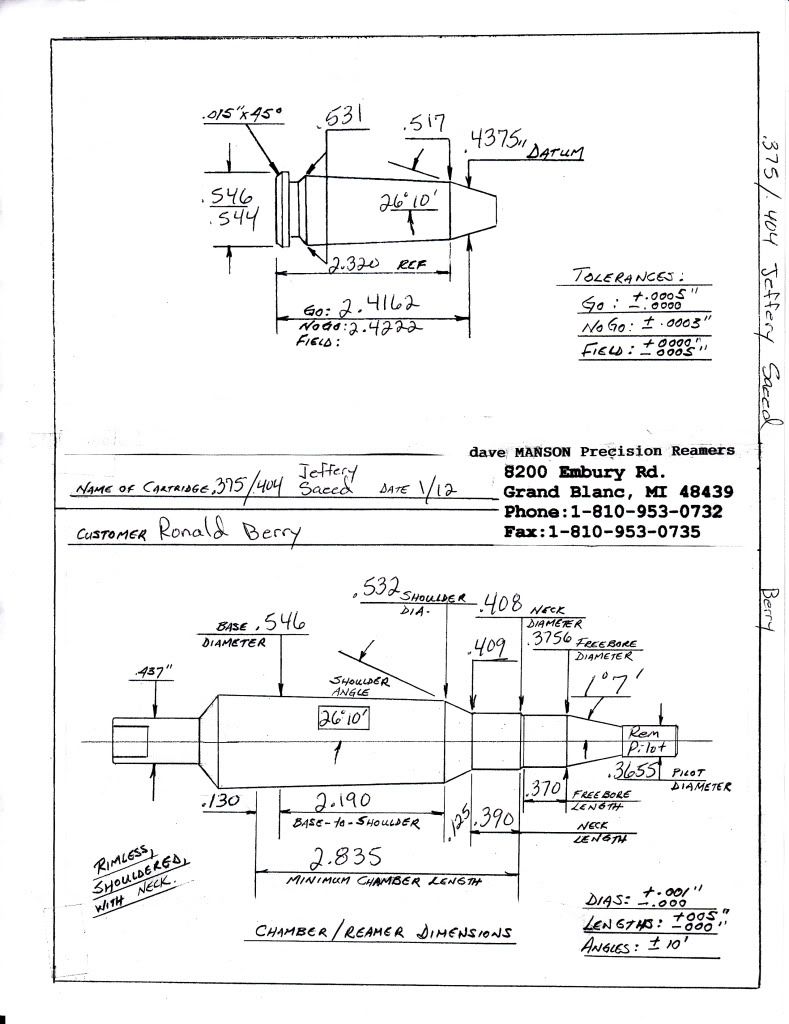 And the below MI dummies used for Go Gages, and some bullets for feed dummies. Graph paper big blocks are 1" and small blocks are 0.1" Approximate throat and bullet ogive relationships can be read from that. 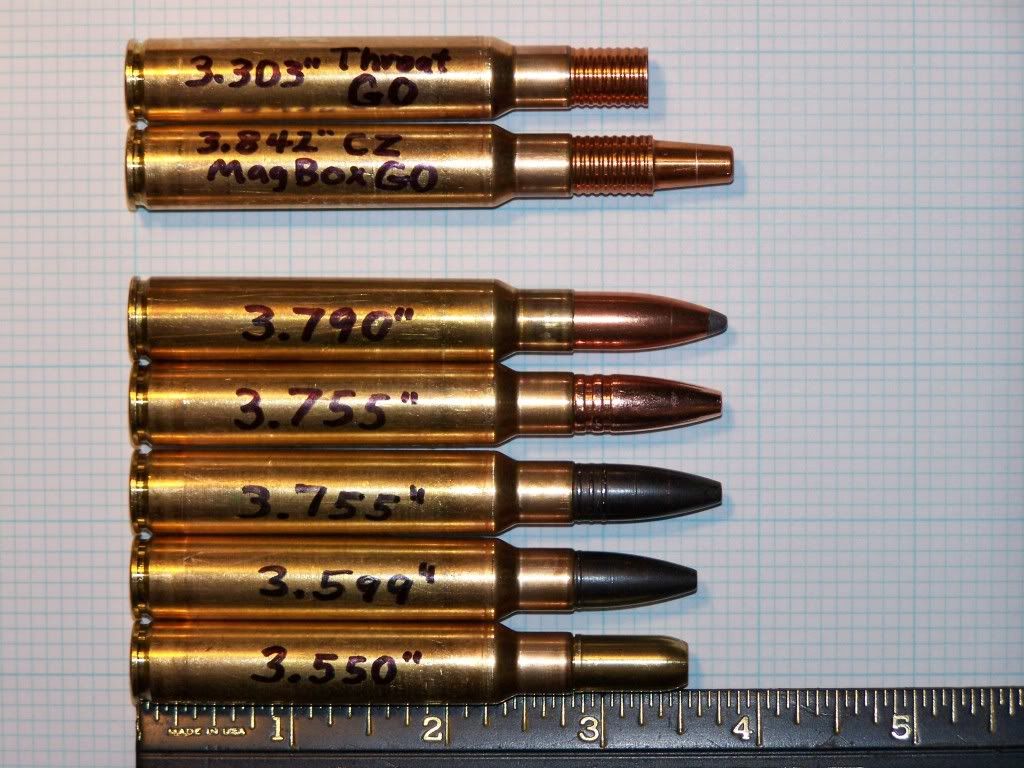 The feed dummies work well. The brass solid is a Barnes Banded ogived FN. That is a generic FN and all other solids can be loaded shorter: North Fork, CEB, GSC When loaded short the FN solids feed well. Not good when loaded long. They are accurate enough for 100 yard work. The North Fork CPS at 3.445" COL feeds well and two shots with that went into 0.365" at 50 yards, POI was right on either side of dead center POA, and velocity was 2717 fps with starting load of 85 grains H4350. Chronographed 3 shots but I pulled the third shot with that load. Excited? Bullet fever? Too embarrassed to show that target. Will repeat at 100 yards next time out. Note: All bullets for the .375/404 JS, mentioned or pictured in this post, are 300-grainers, except for the Groove MI throat and box gage bullets which are 265-grainers. BTW, Pac-Nor shipped my .375-caliber barrel to Rusty McGee today. Passed QC. 1:10" twist. I think it is going to go onto a CZ 404 Jeffery rifle that feeds perfectly. I got a free CZ Kevlar stock for that factory rifle because the fancy walnut broke off at the wrist. Will keep current throat. | |||
|
One of Us |
Ron, You’re welcome… LOL… I pulled those tolerances off the reamer drawing on page 1 of the thread – just thought putting it in a line listing might prod some thinking cells from those reading the thread and elicit some comments… I like lineup of dummy cartridges as well as your ‘Throat Go’ and ‘CZ Mag Box Go’ dummy cases.  You’re truly optimizing your CZ’s magazine capabilities with this length of cartridge and your throat dimensions. I’ve saved the photo for future reference… Ok…so back to the 0.446” EFB of your .375/404 JS chamber… My note added in red… Ok so now this setup consumes 0.212” of the 0.446” EFB leaving 0.232” of ‘bullet jump’ – that definitely ought to tighten your groups with this bullet… Looks like the 300gr GK at 3.790” and 300gr TSX at 3.755” to ought to tighten up nicely as well… It’s too bad CEB doesn’t have a .375 caliber MTH with 1.032” or less bullet protrusion – it’d definitely make use of your CZ magazine length as well as give you something well north of .600 BC for long range shooting. Here’s a Jim "Life's hard; it's harder if you're stupid" John Wayne | |||
|
| one of us |
Saeed is wasting magazine space for his sub-3.7" COL in a Rigby box. His long-nose bullet makes loading his 2.820" case into an H&H length magazine impossible. I am looking for a "Super Walterhog" bullet that fills the box and throat of my rifle and has a pointy hollow nose some boat tail and full bearing inside the neck of the cartridge. Monometal copper it will have to be, and 300 grains in weight. The "Super" aspect comes from the greater velocity for the 300 grainer allowed by the long box and long throat, lesser case capacity intrusion, loaded to same pressure as a Walterhog, but with COl of 3.8", and striving for a BC approaching just south of .5. Feasible? Pencil sketch of a bullet is next on the drawing board, to see if it is possible. Wasteful as they are, the good Walterhog 300-grainers in a long box and a short throat worked well in Tanzania yesterday: 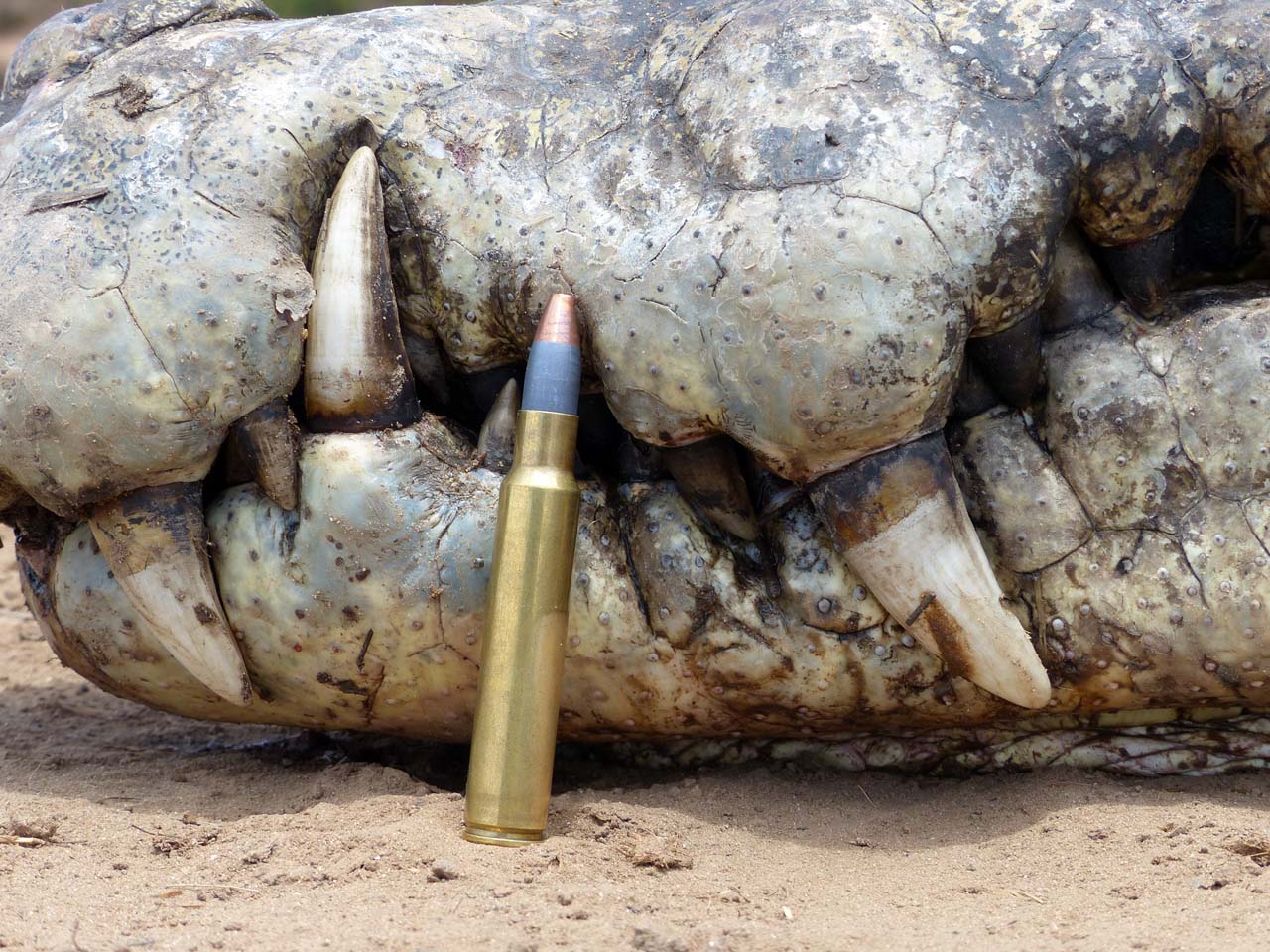 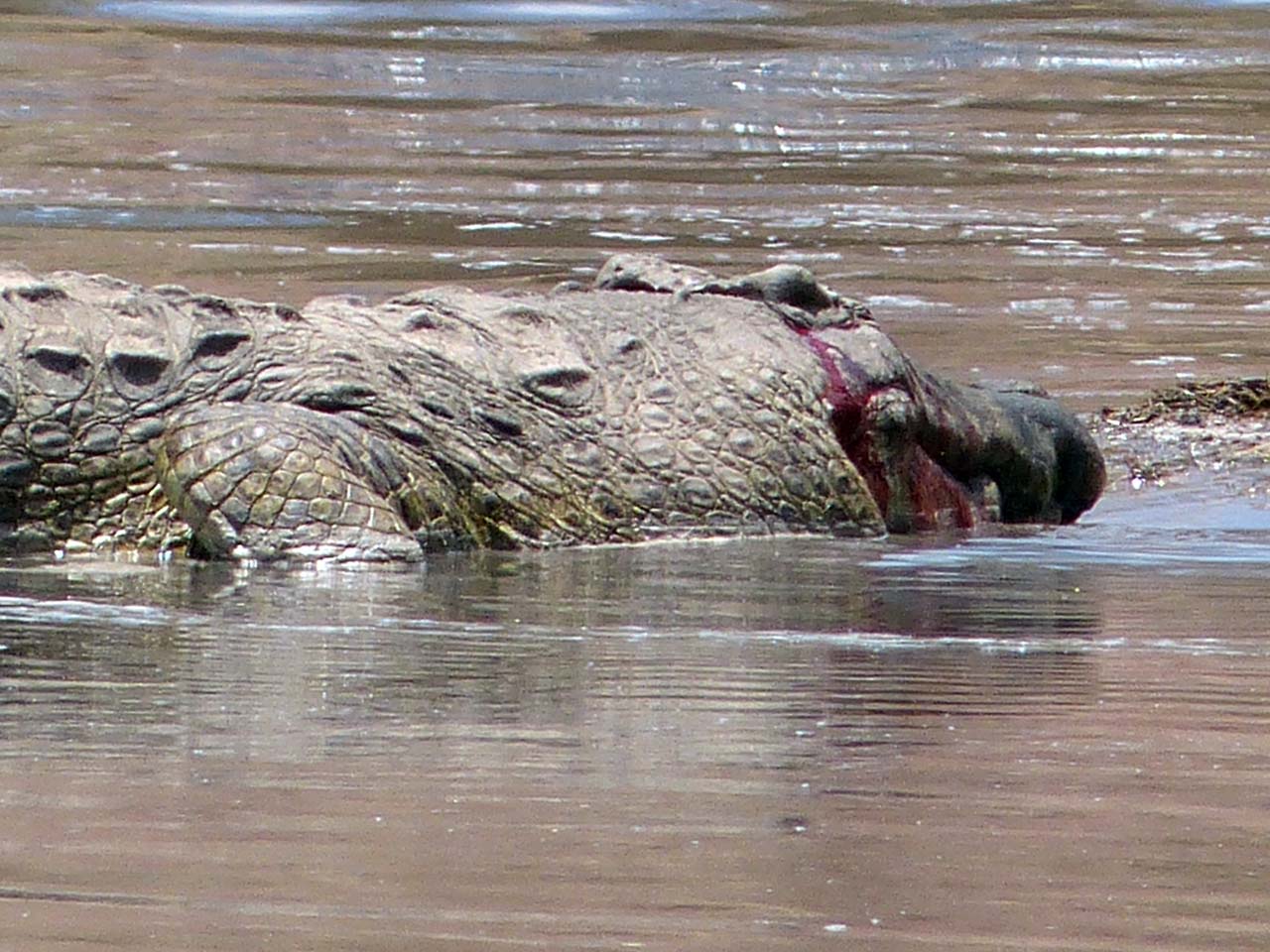 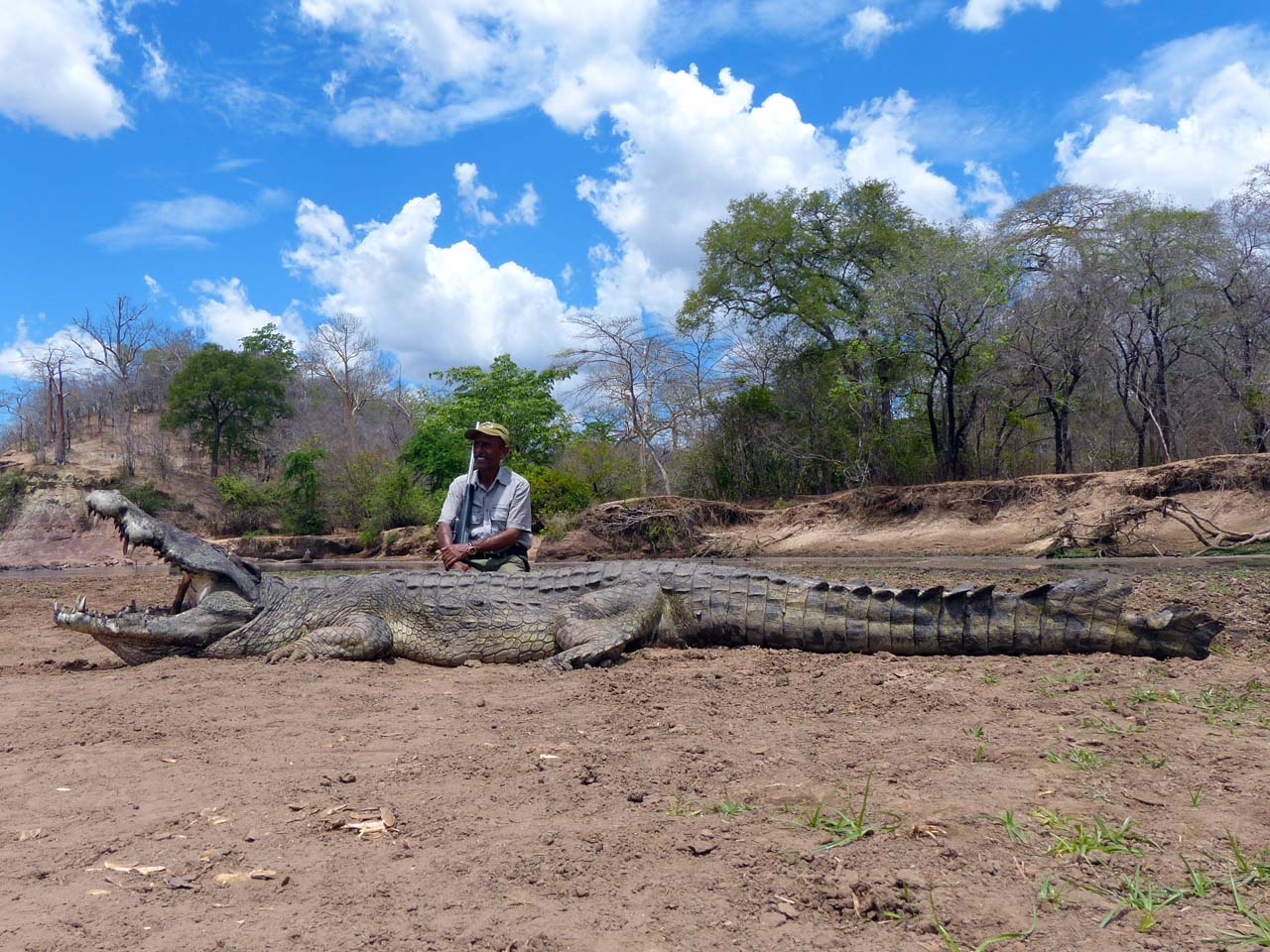 Rearend of Walterhog protruding from the off side of a Godzilla of a crocodile: 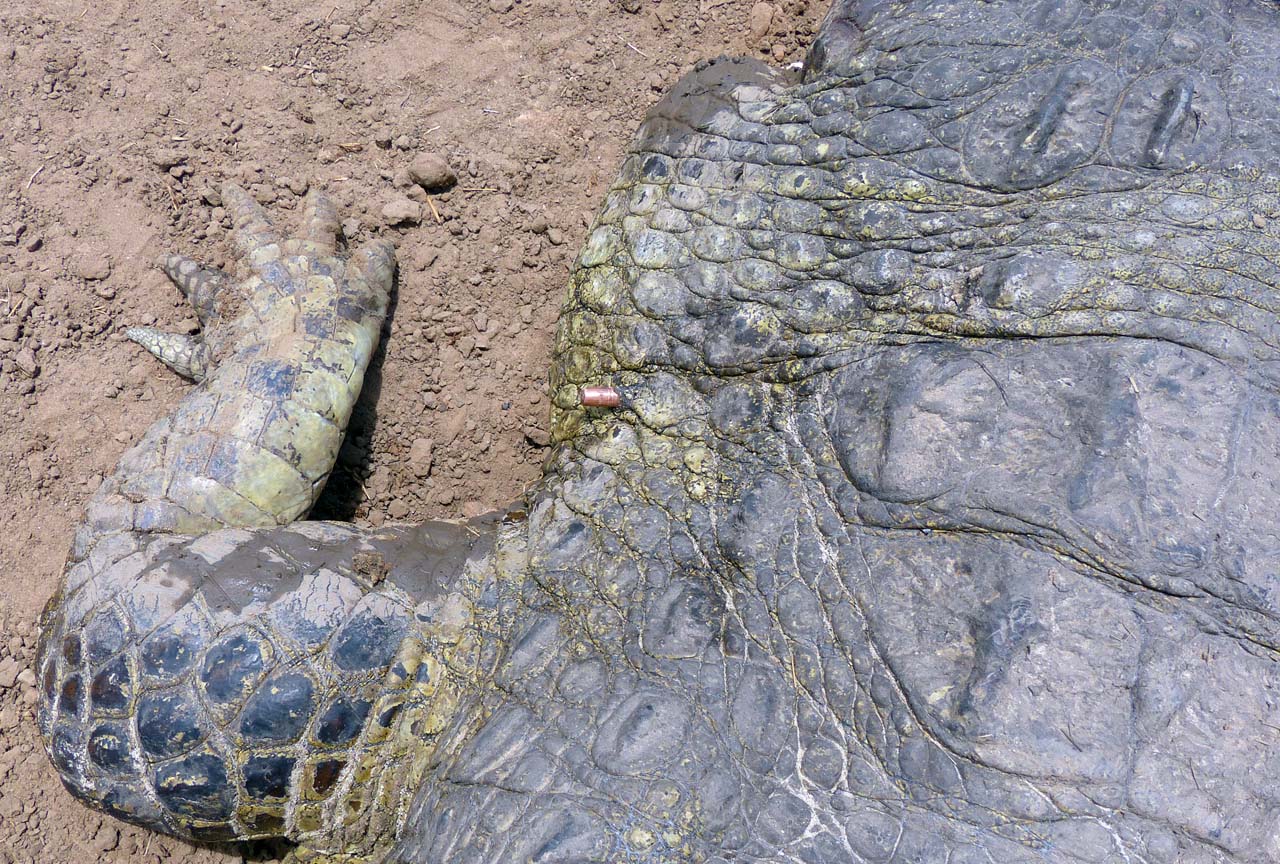 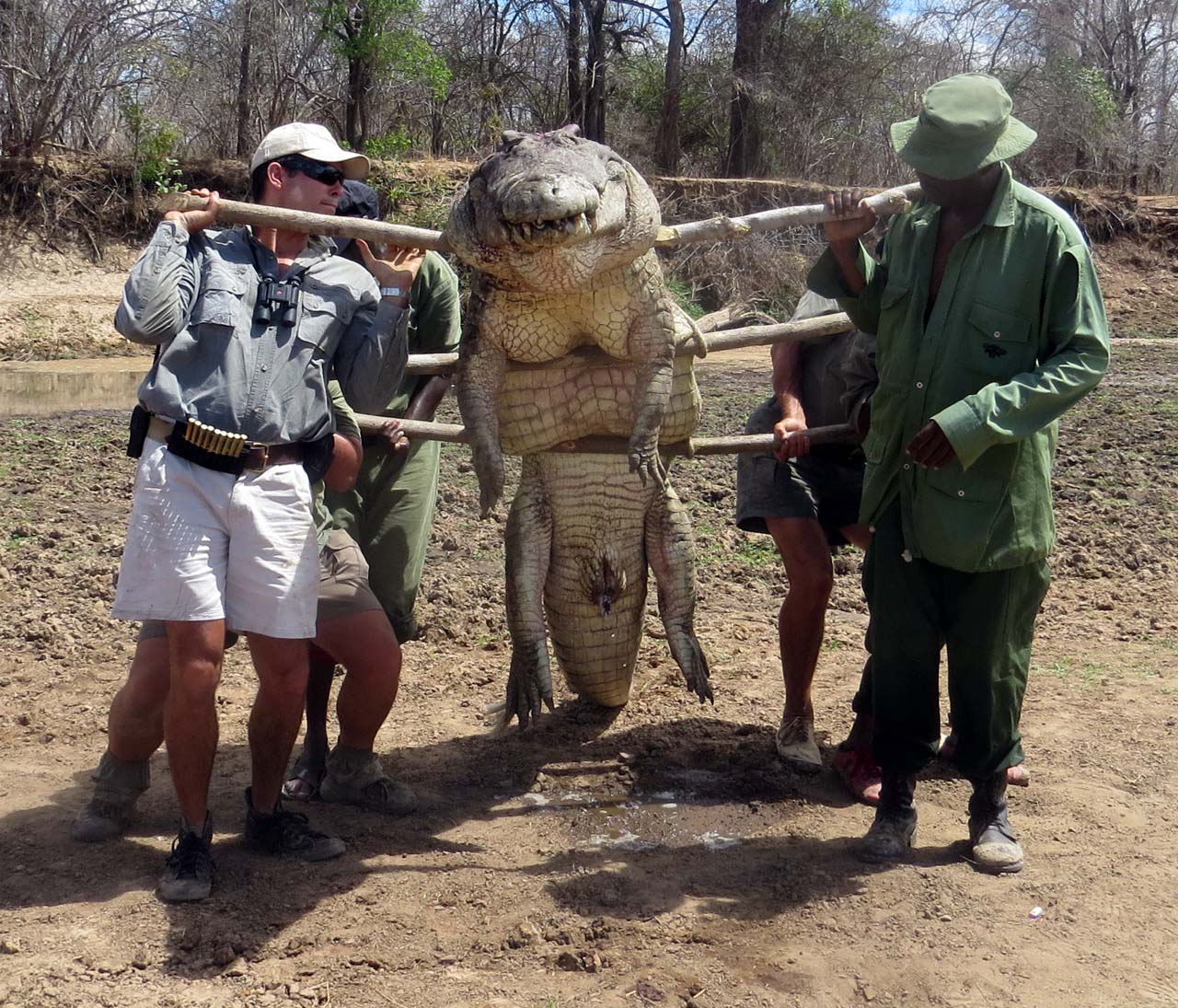 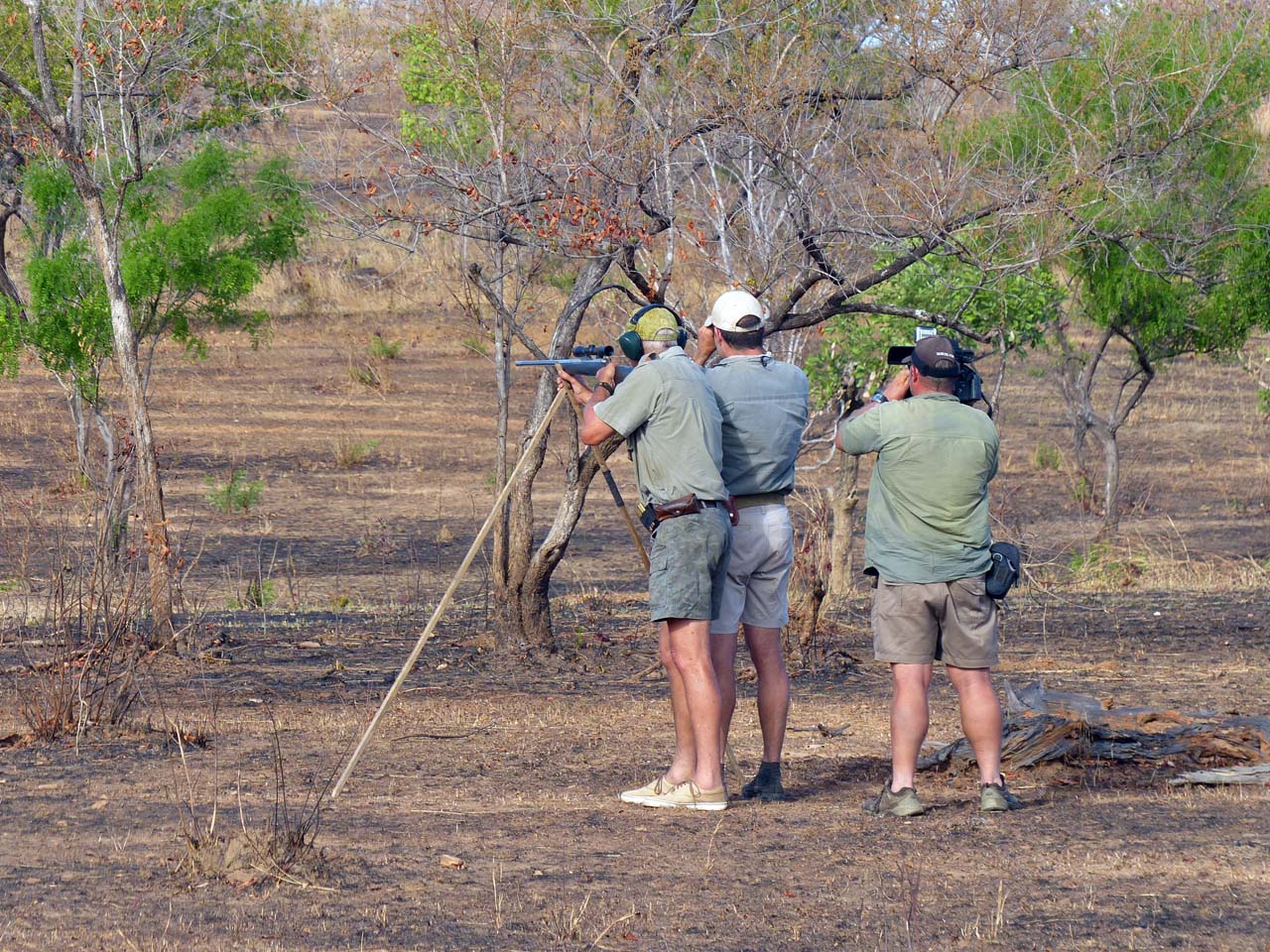 Frontal brain shot on warthog by Walterhog? Versatile enough for varmints and buffalo: 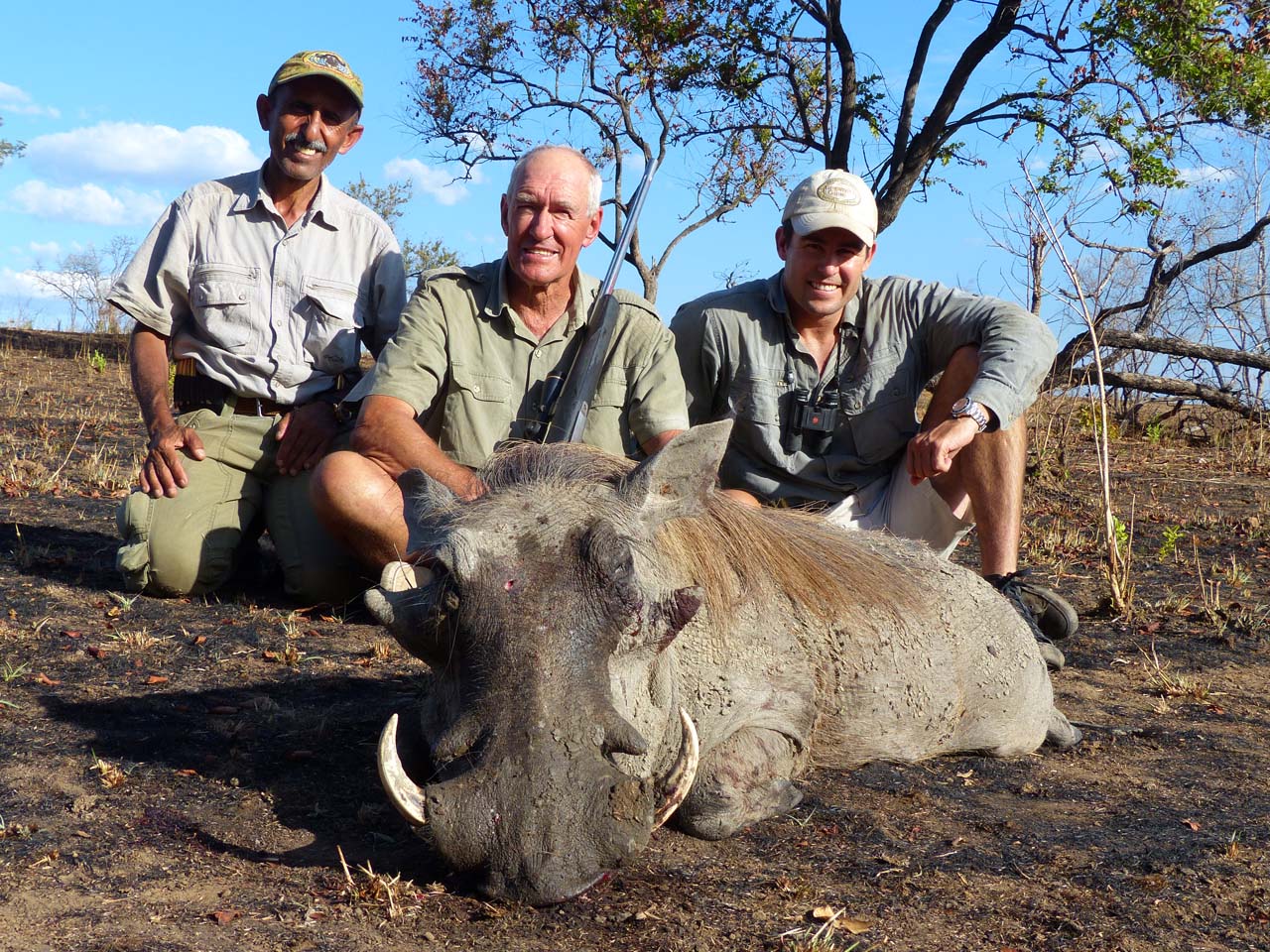 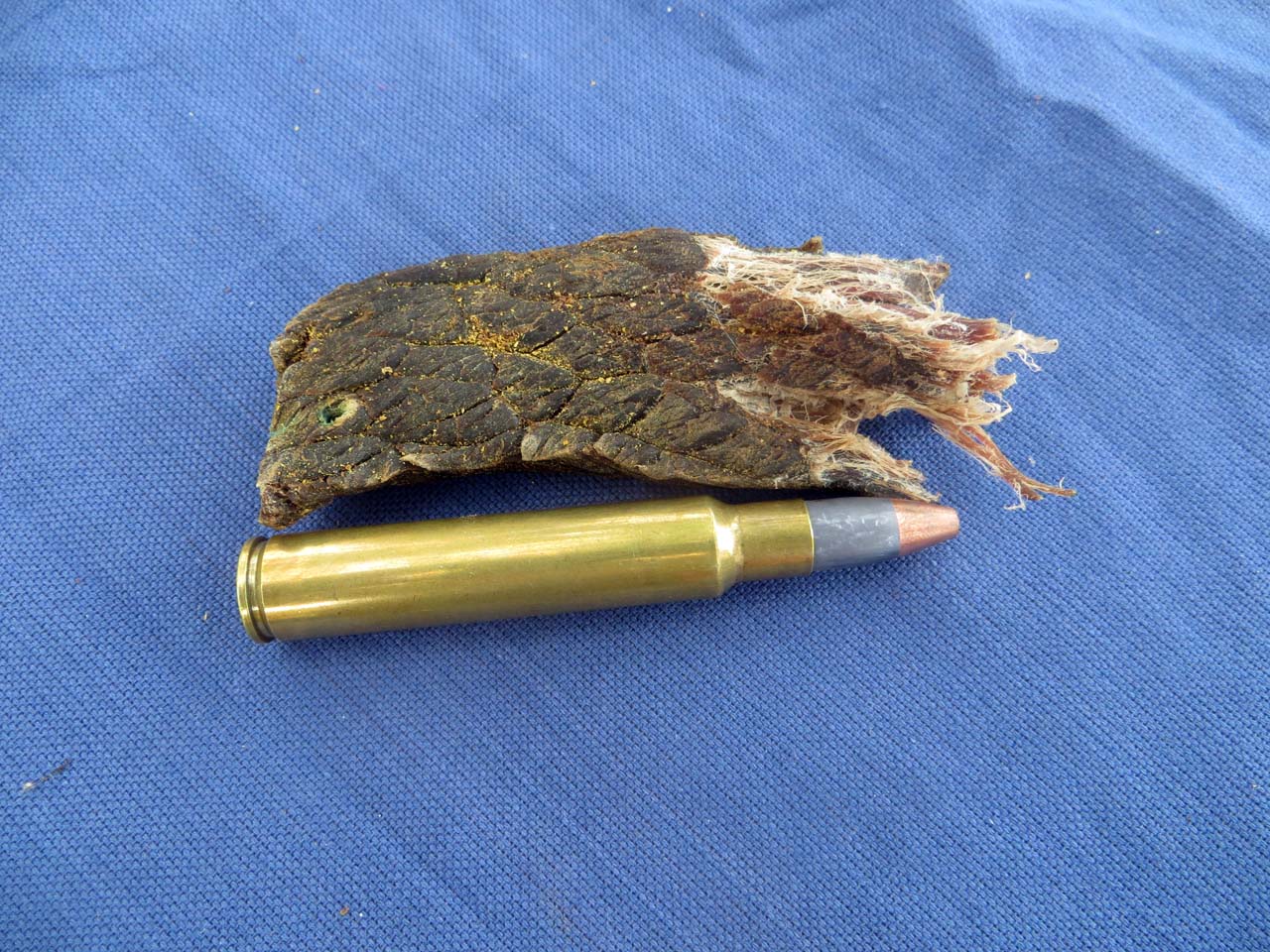 Making a stand like the plains buffalo hunters of the 1870s, with the advantage of a Leupold: 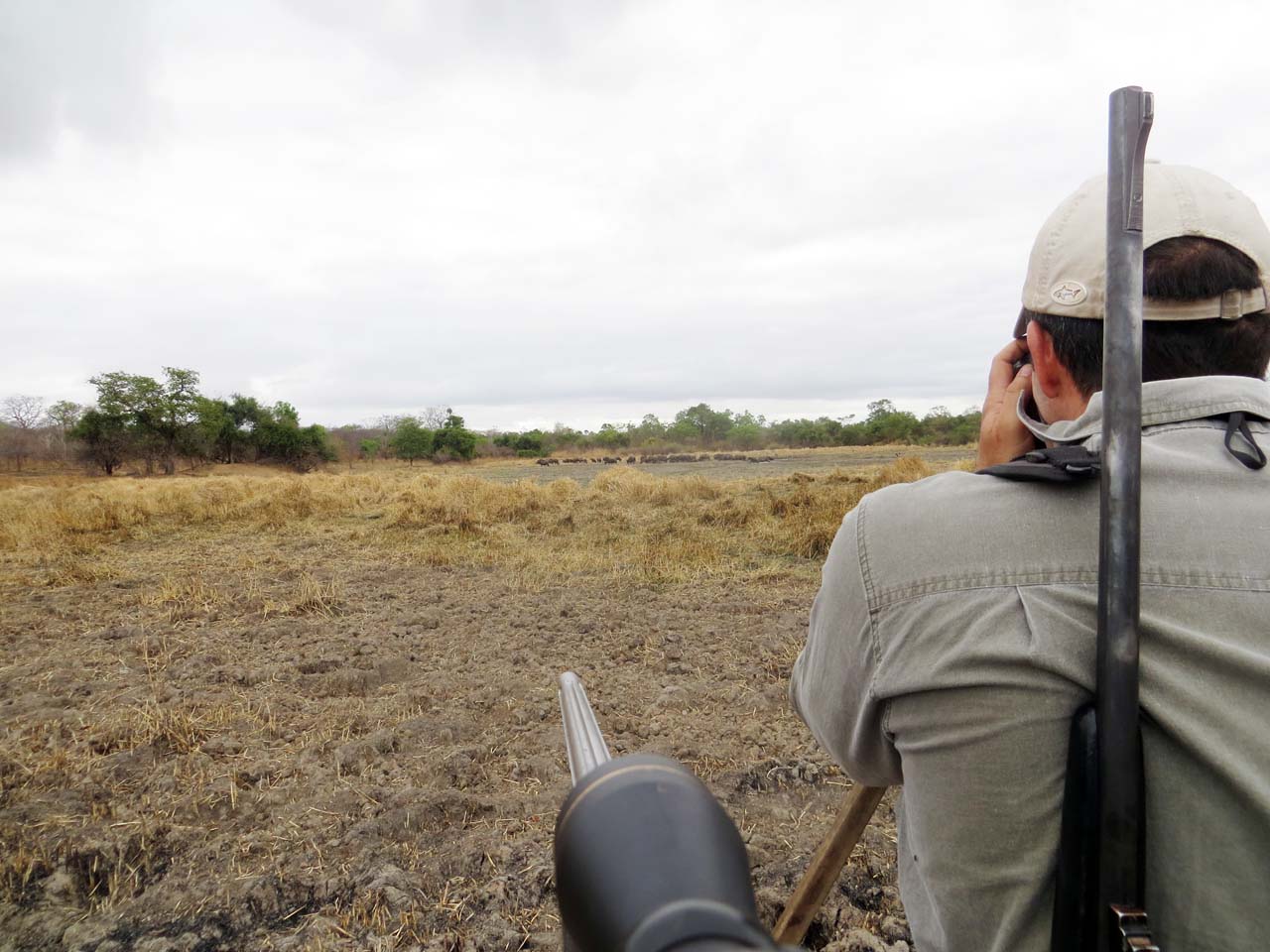 | |||
|
One of Us |
Yes Saeed is wasting space in the Rigby length magazine but it obviously is working out just fine for him. Have you had a chance to shoot the 320gr CEB MTH L04 bullets yet? I know they're to long to seat the Seal Tote band against the case mouth - but if they're accurate, you could have Dan shorten the nose protrusion sufficient to feed from your magazine - should still have a +.700 BC for the bullet... And it would give Dan a potential 'standard' .375 caliber bullet to sell to guys using .375 H&H (and other long magnum cartridges) within the CZ 550 Magnum length action (or similar magazine length actions). Just a thought... Jim "Life's hard; it's harder if you're stupid" John Wayne | |||
|
| Powered by Social Strata | Page 1 2 3 4 5 6 7 |
| Please Wait. Your request is being processed... |
|
 The Accurate Reloading Forums
The Accurate Reloading Forums  THE ACCURATE RELOADING.COM FORUMS
THE ACCURATE RELOADING.COM FORUMS  Rifles
Rifles  Big Bores
Big Bores  .375/404 Jeffery Saeed of 2012: Adventures and Misadventures
.375/404 Jeffery Saeed of 2012: Adventures and Misadventures

Visit our on-line store for AR Memorabilia

